Selected
Takao 599 museum has all kinds of animals inhabit in Mt. Takao in various ways of exhibitions such as seasonal wild plants preserved in acrylic and all kinds of animals specimens inhibits in Mt. Takao. On the "NATURE WALL," stuffed animals are displayed and shows the movie to introduce the dynamic nature of Mt. Takao.
-
Pertya robusta Compositae
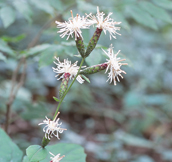
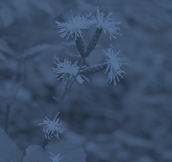 Pertya robusta Compositae
Pertya robusta Compositae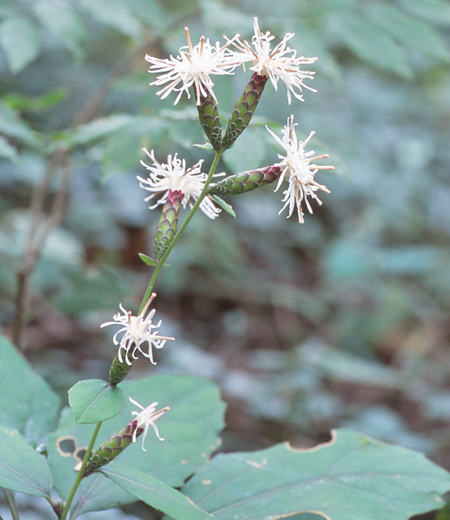 They are a perennial plant that grows at the arid places such as in the pool of the forests and in the forests at the mountain area (Perennial plant takes several years to grow). The rhizome (Konkei) creeps sideways and the stalks are not split but expand straight. The flower consists of apitulum (Touka: a flower consisting of small dense tubular flowers) of 10 small flowers in cluster, and 5 to 6 of them are on the upper part of the stalk. The flower is tinged with white with the tips split into 5 and curled back. A circular cylindrical shape involucre (Soho: a portion like a bud to cover) lie below the flower, about 1.7 to 2.7 cm long. The leaf is elliptically-shaped like the one of Quercus dentate, about 10 to 20 cm long, with coarse sawtooth at the edge (Kyoshi: tooth-like rough part like a saw at the root of a leaf). They have a long stalk and the leaves grow alternative in cluster in the middle of the stalk. When the flowers wither, they bear the seeds about 1.4 cm long and with floss. In the winter, the liquid inside the withered stems get frozen to be swollen to be ‘Shimobashira’ (Ice Flower).
They are a perennial plant that grows at the arid places such as in the pool of the forests and in the forests at the mountain area (Perennial plant takes several years to grow). The rhizome (Konkei) creeps sideways and the stalks are not split but expand straight. The flower consists of apitulum (Touka: a flower consisting of small dense tubular flowers) of 10 small flowers in cluster, and 5 to 6 of them are on the upper part of the stalk. The flower is tinged with white with the tips split into 5 and curled back. A circular cylindrical shape involucre (Soho: a portion like a bud to cover) lie below the flower, about 1.7 to 2.7 cm long. The leaf is elliptically-shaped like the one of Quercus dentate, about 10 to 20 cm long, with coarse sawtooth at the edge (Kyoshi: tooth-like rough part like a saw at the root of a leaf). They have a long stalk and the leaves grow alternative in cluster in the middle of the stalk. When the flowers wither, they bear the seeds about 1.4 cm long and with floss. In the winter, the liquid inside the withered stems get frozen to be swollen to be ‘Shimobashira’ (Ice Flower).
●Season Mid September to about Mid October
●Height about 30 to 70 cm
●Place Trail 1 to 6, Mt.Inari, Jyataki, Ura-Takao, Oku-Takao -
Rhynchospermum verticillatum Compositae
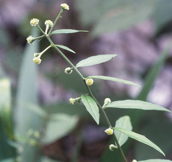
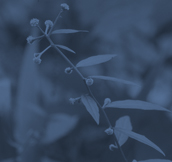 Rhynchospermum verticillatum Compositae
Rhynchospermum verticillatum Compositae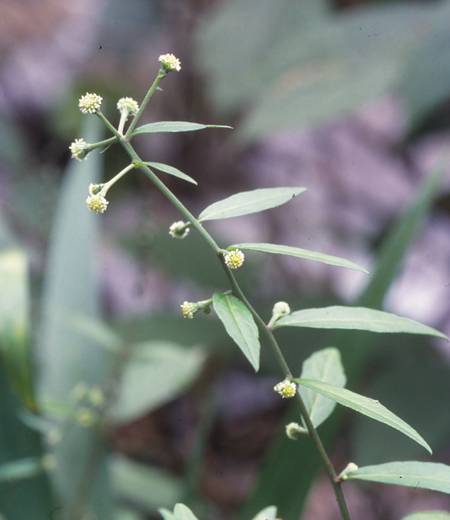 They are a perennial plant that grows in the pool of the forests and at the roadsides along the mountain streams at the mountain area (Perennial plant takes several years to grow). Their flowers come into high season around the time when the autumn is come. This is the reason for the name. When the stalk grows to be about 1 m high, it shoots 2 to 4 of offshoots and bears a small flower at the top of the short stem growing from the side of the leaf. The flower consists of apitulum (Touka: a flower consisting of small dense tubular flowers, to be like one flower), about 5 mm, tinged with pale yellow-green. In its center, gathers a tubular flower (Toujoka: tubular corolla that gathers dense in the center, also a flower with no flower petals) with the tip split into 5, while small white flower petals like protuberance around it queue up in 2 lines to surround. The leaf is thin and long elliptically-shaped, about 7 to 15 cm long, about 2 to 3 cm wide with the sharp top, and has hard and short trichome on (Shiga: a gyrose jagged part) both surfaces, rough feeling to touch with a gyrose tooth(at the edge of the upper portion. When he flowers wither, they bear the elliptically-shaped, seeds about 2.5 mm long.
They are a perennial plant that grows in the pool of the forests and at the roadsides along the mountain streams at the mountain area (Perennial plant takes several years to grow). Their flowers come into high season around the time when the autumn is come. This is the reason for the name. When the stalk grows to be about 1 m high, it shoots 2 to 4 of offshoots and bears a small flower at the top of the short stem growing from the side of the leaf. The flower consists of apitulum (Touka: a flower consisting of small dense tubular flowers, to be like one flower), about 5 mm, tinged with pale yellow-green. In its center, gathers a tubular flower (Toujoka: tubular corolla that gathers dense in the center, also a flower with no flower petals) with the tip split into 5, while small white flower petals like protuberance around it queue up in 2 lines to surround. The leaf is thin and long elliptically-shaped, about 7 to 15 cm long, about 2 to 3 cm wide with the sharp top, and has hard and short trichome on (Shiga: a gyrose jagged part) both surfaces, rough feeling to touch with a gyrose tooth(at the edge of the upper portion. When he flowers wither, they bear the elliptically-shaped, seeds about 2.5 mm long.
●Season Mid September to about Mid October
●Height about 50 to 90 cm
●Place Trail 1 to 6, Mt. Inari, Jyataki, Ura-Takao -
Vicia unijuga Leguminosae
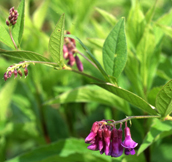
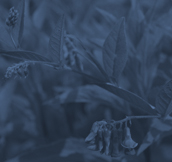 Vicia unijuga Leguminosae
Vicia unijuga Leguminosae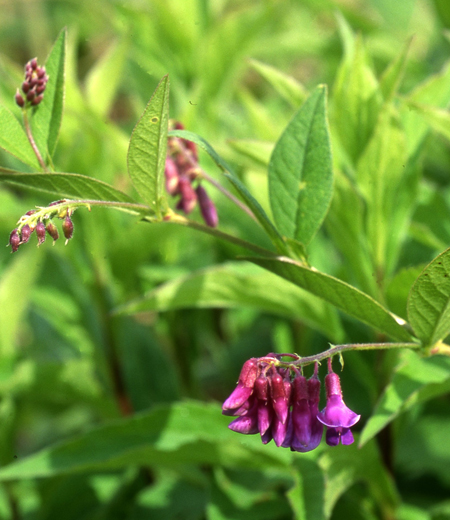 Perennial herbs (grow for several years from their same root system) found in sunny forest edges and riverbanks. Upright stems have fin-like ribs. Flowers are 1..5 cm long and tips are pointed like butterflies. Color of flowers is red-purple and bloom on 2 to 4 cm inflorescence. Leaves are two-leaves compound leaves and alternate. Each leaf is 3 to 7 cm long, long egg-shaped, hairy and with short petioles. The Japanese name Nanten-hagi was named because the shape of leaves resembles nandina domestica (nanten in Japanese and hagi is bush clover). This is also called Futaba-hagi literally meaning two leaves bush clover named after the two compounded leaves. After flowering, bear 3 cm long loment like peas with three to seven seeds. Sprout in spring is called Azukina and can be eaten as wild vegetable.
Perennial herbs (grow for several years from their same root system) found in sunny forest edges and riverbanks. Upright stems have fin-like ribs. Flowers are 1..5 cm long and tips are pointed like butterflies. Color of flowers is red-purple and bloom on 2 to 4 cm inflorescence. Leaves are two-leaves compound leaves and alternate. Each leaf is 3 to 7 cm long, long egg-shaped, hairy and with short petioles. The Japanese name Nanten-hagi was named because the shape of leaves resembles nandina domestica (nanten in Japanese and hagi is bush clover). This is also called Futaba-hagi literally meaning two leaves bush clover named after the two compounded leaves. After flowering, bear 3 cm long loment like peas with three to seven seeds. Sprout in spring is called Azukina and can be eaten as wild vegetable.
●Season June to about October
●Height about 30 to 60 cm
●Place Ura-Takao -
Amphicarpaea edgeworthii var. japonica Leguminosae
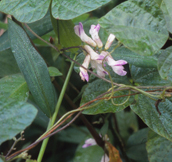
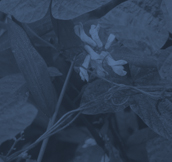 Amphicarpaea edgeworthii var. japonica Leguminosae
Amphicarpaea edgeworthii var. japonica Leguminosae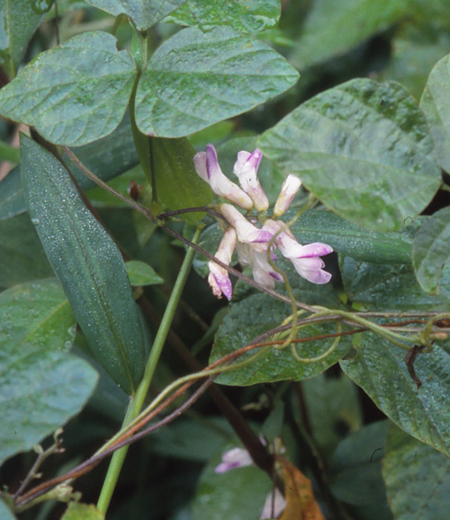 They are an annual plant that grows in the pool of the forests and at the grasslands in sunny mountain district. The stalk grows thickly downward paraphyllium and is thin and long to expand about 1 m to tangle in the other vegetation. We see them mostly in thicket, and then this is why they are named. The flower is about 2 cm long with the top being like a butterfly-shaped. The whitish edge of the flower petal is dark purple color and some are on inflorescence (Kajo: stalk blooming flowers) grown from the side of the leaf. Another characteristic is that except this flower, they have cleistogamous flower (Heisaka: the flower which does not blossom but pollinates itself) both on the ground and at the underground stem. The leaf consists of 3 as one and grows alternative. Lobules are wide egged-shaped about 3 to 6 cm long (Shoyo: each one that is leaf-shaped and leaf like one consisting of more than a few leaves) has paraphyllium to grow. When the flowers wither, they bear the hull-shaped seeds. When matured, the seeds are split half out to produce quail-egged shaped seedlings with black patterns.
They are an annual plant that grows in the pool of the forests and at the grasslands in sunny mountain district. The stalk grows thickly downward paraphyllium and is thin and long to expand about 1 m to tangle in the other vegetation. We see them mostly in thicket, and then this is why they are named. The flower is about 2 cm long with the top being like a butterfly-shaped. The whitish edge of the flower petal is dark purple color and some are on inflorescence (Kajo: stalk blooming flowers) grown from the side of the leaf. Another characteristic is that except this flower, they have cleistogamous flower (Heisaka: the flower which does not blossom but pollinates itself) both on the ground and at the underground stem. The leaf consists of 3 as one and grows alternative. Lobules are wide egged-shaped about 3 to 6 cm long (Shoyo: each one that is leaf-shaped and leaf like one consisting of more than a few leaves) has paraphyllium to grow. When the flowers wither, they bear the hull-shaped seeds. When matured, the seeds are split half out to produce quail-egged shaped seedlings with black patterns.
●Season September to about October
●Height – climbing plant
●Place Trail 1, Trail 4 to 6, Ura-Takao -
Cimicifuga simplex Ranunculaceae
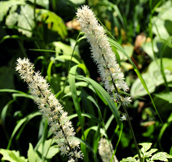
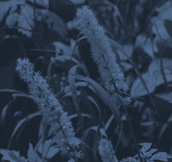 Cimicifuga simplex Ranunculaceae
Cimicifuga simplex Ranunculaceae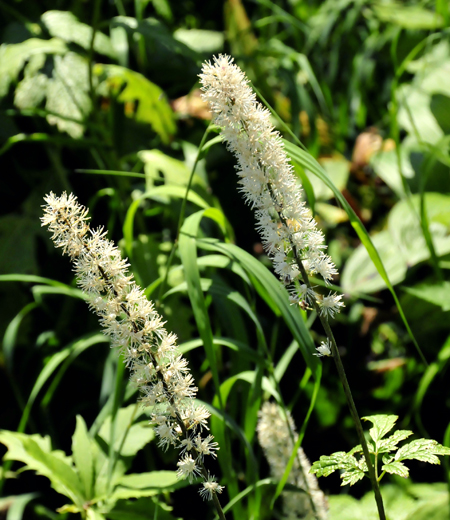 They are perennial plant that grows under the trees of mountain district and along the mountain stream. (Perennial plant takes several years to grow). They bear spikes (Kasui: small flowers gathering to be like head of plant) brush-shaped about 10 to 30 cm at the grown-high stalk. The spikes hold more than 150 flowers about 5 to 7 cm long. Though they resemble Cimicifuga japonica in the same group, the good difference to distinguish is that Cimicifuga simplex’s leaves differ from the ones of Cimicifuga japonica, and Cimicifuga simplex’s flowers have a stalk about 1 cm long. The leaf consists three as one named compound leaf, with a long stalk growing alternative to stem. Lobules (Shoyo: each one that is leaf-shaped and leaf like one consisting of more than a few leaves) is egged-shaped about 3 to 8 cm long, has a sharp tip and with spiny sawtooth at the edge (Kyoshi: tooth-like rough part like a saw at the root of a leaf). How they are named is people boiled the fresh leaves and immersed them in ice water to eat, and then they are called ‘Cimicifuga simplex’ (Sarashina-shoma). Shoma is a Chinese name. After flowers wither, they bear the seeds about 1 cm long. When matured, the seeds get split up and produce the seeds with shallow wrinkles.
They are perennial plant that grows under the trees of mountain district and along the mountain stream. (Perennial plant takes several years to grow). They bear spikes (Kasui: small flowers gathering to be like head of plant) brush-shaped about 10 to 30 cm at the grown-high stalk. The spikes hold more than 150 flowers about 5 to 7 cm long. Though they resemble Cimicifuga japonica in the same group, the good difference to distinguish is that Cimicifuga simplex’s leaves differ from the ones of Cimicifuga japonica, and Cimicifuga simplex’s flowers have a stalk about 1 cm long. The leaf consists three as one named compound leaf, with a long stalk growing alternative to stem. Lobules (Shoyo: each one that is leaf-shaped and leaf like one consisting of more than a few leaves) is egged-shaped about 3 to 8 cm long, has a sharp tip and with spiny sawtooth at the edge (Kyoshi: tooth-like rough part like a saw at the root of a leaf). How they are named is people boiled the fresh leaves and immersed them in ice water to eat, and then they are called ‘Cimicifuga simplex’ (Sarashina-shoma). Shoma is a Chinese name. After flowers wither, they bear the seeds about 1 cm long. When matured, the seeds get split up and produce the seeds with shallow wrinkles.
●Season Late September to about Late October
●Height about 60cm to 1.2 m
●Place Trail 1, Trail 4 to 6, Mt.Inari, Ura-Takao, Oku-Takao -
Amaryllidaceae Amaryllidaceae
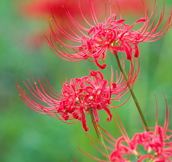
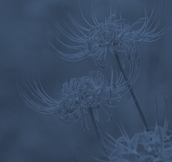 Amaryllidaceae Amaryllidaceae
Amaryllidaceae Amaryllidaceae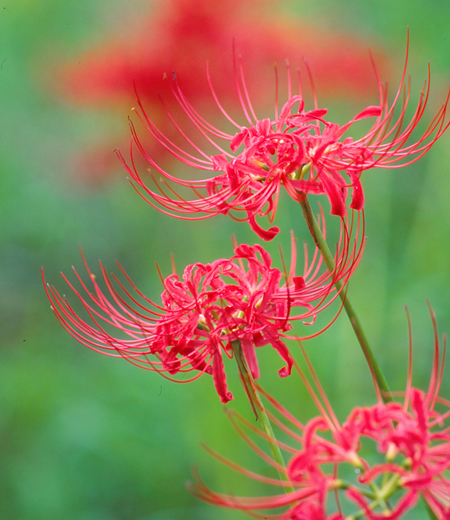 They are perennial plant that grows in clusters in the river bank, footpath between rice fields, and graveyards (Perennial plant takes several years to grow). It is thought that they were imported from ancient China. The reason for their name is that around the time of autumn during equinoctial week, they bear bright red flowers. They also have another name ‘Lycoris radiata’ which means the unworldly red flower in the Lotus Sutra. At the top of the upright-growing flower stalk (Kakei: stem of flower bearing only flowers without leaves) sprouting from the bulb (Rinkei: a modified leaf by nutrient accumulation being attached firmly to short stalk), 5 to 7 flowers bloom in a cluster. The flower has 6 thin flower petals about 4 centimeters long rolled back and a male stamen projects long. No leaves sprout during blooming, grow in latest autumn, pass the winter through, and wither in the next spring. The leaf is thin and long about 30 to 60 cm long, 6 to 8 mm wide. The leaves are dark shiny green color with the center in whitish color along the leaf vein. Entire portions of this plant contain poisonous elements, especially much in discoid stem (bulb). When eaten by mistake, this poison brings about the symptoms such as vomiting and diarrhea, in some cases, may lead to death.
They are perennial plant that grows in clusters in the river bank, footpath between rice fields, and graveyards (Perennial plant takes several years to grow). It is thought that they were imported from ancient China. The reason for their name is that around the time of autumn during equinoctial week, they bear bright red flowers. They also have another name ‘Lycoris radiata’ which means the unworldly red flower in the Lotus Sutra. At the top of the upright-growing flower stalk (Kakei: stem of flower bearing only flowers without leaves) sprouting from the bulb (Rinkei: a modified leaf by nutrient accumulation being attached firmly to short stalk), 5 to 7 flowers bloom in a cluster. The flower has 6 thin flower petals about 4 centimeters long rolled back and a male stamen projects long. No leaves sprout during blooming, grow in latest autumn, pass the winter through, and wither in the next spring. The leaf is thin and long about 30 to 60 cm long, 6 to 8 mm wide. The leaves are dark shiny green color with the center in whitish color along the leaf vein. Entire portions of this plant contain poisonous elements, especially much in discoid stem (bulb). When eaten by mistake, this poison brings about the symptoms such as vomiting and diarrhea, in some cases, may lead to death.
●Season Mid September to about Late September
●Height about 30 to 50 cm
●Place Ura-Takao,Oku-Takao -
Torreya nucifera Taxaceae
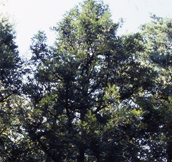
 Torreya nucifera Taxaceae
Torreya nucifera Taxaceae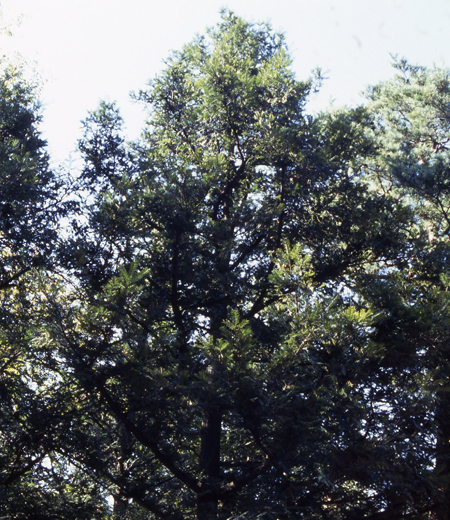 They are ever green arboreal that grows in mountains. Cortex of seedling is pale grey and smooth feeling to touch but when matured, they are divided to be peeled off likely oblong in line. The trunks are about 2 m wide, their lumbers are superior in close and having durability, and so they are widely used for construction materials. Their leaves are about 2 to 3 cm long, about 2 to 3 cm wide and long. They are very tough and luster with the top of them is sharp. When we touch them, it is painful for us unlike Dog Torreya. Their blossom seasons are about April to May, and a dioecious plant (Shiyuuisyu). They have a male flower beside the leaf of the branch that grew the previous year, and a female flower at the top of the branch.Their fruits are elliptically-shaped about 2 to 4 cm long, an aril (Kahisyu) like lichen covers seeds, and next October they are matured. Their seeds are very spicy and delicious when removed of astringent taste and roasted.
They are ever green arboreal that grows in mountains. Cortex of seedling is pale grey and smooth feeling to touch but when matured, they are divided to be peeled off likely oblong in line. The trunks are about 2 m wide, their lumbers are superior in close and having durability, and so they are widely used for construction materials. Their leaves are about 2 to 3 cm long, about 2 to 3 cm wide and long. They are very tough and luster with the top of them is sharp. When we touch them, it is painful for us unlike Dog Torreya. Their blossom seasons are about April to May, and a dioecious plant (Shiyuuisyu). They have a male flower beside the leaf of the branch that grew the previous year, and a female flower at the top of the branch.Their fruits are elliptically-shaped about 2 to 4 cm long, an aril (Kahisyu) like lichen covers seeds, and next October they are matured. Their seeds are very spicy and delicious when removed of astringent taste and roasted.
●Height about 20 to 30 m
●Place Trail 3 and 4, Ura-Takao -
Pinus densiflora Pinaceae
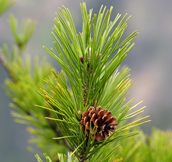
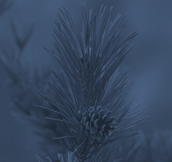 Pinus densiflora Pinaceae
Pinus densiflora Pinaceae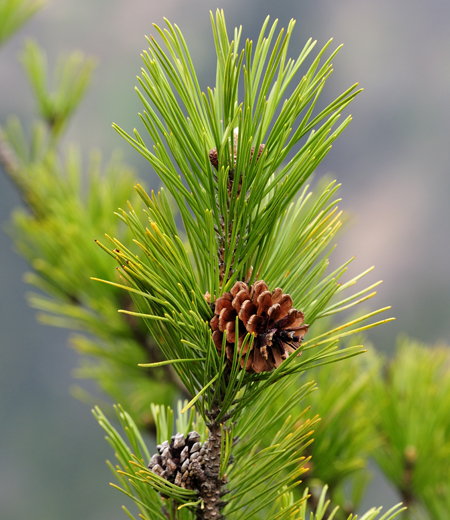 They are a deciduous tall tree that bears needle-like leaves. The trunk grows to be about 1.2 m wide, and is often planted for garden trees and windbreak forests. Cortex is tinged with red, therefore, they are named ‘Pinus densiflora’ (Akamatsu). Though they look like Pinus thunbergii Parlatore (Kuromatsu) in the same group of Pinaceae, the leaves of Akamatsu are rather thin and soft. This fact results in calling Kuromatsu by ‘male pine tree’ and Akamatsu by ‘female pine tree’. They survive to grow even at arid and poor soil to grow wild along the ridge of a plateau located around 2,000 m above sea level. Decades ago, we used to see Akamatsu even at Mt. Takao, but nowadays we seldom see them. The blossom seasons are about April to May and hermaphroditism plant (Shiyuudousyu). Yellow male flowers sprout on a new branch, while 2 to 3 of purple-red female flowers sprout at the limb of the branch. The seeds are egged-shaped and get matured next autumn to be woodsy pinecone (Matsu-bokkuri).
They are a deciduous tall tree that bears needle-like leaves. The trunk grows to be about 1.2 m wide, and is often planted for garden trees and windbreak forests. Cortex is tinged with red, therefore, they are named ‘Pinus densiflora’ (Akamatsu). Though they look like Pinus thunbergii Parlatore (Kuromatsu) in the same group of Pinaceae, the leaves of Akamatsu are rather thin and soft. This fact results in calling Kuromatsu by ‘male pine tree’ and Akamatsu by ‘female pine tree’. They survive to grow even at arid and poor soil to grow wild along the ridge of a plateau located around 2,000 m above sea level. Decades ago, we used to see Akamatsu even at Mt. Takao, but nowadays we seldom see them. The blossom seasons are about April to May and hermaphroditism plant (Shiyuudousyu). Yellow male flowers sprout on a new branch, while 2 to 3 of purple-red female flowers sprout at the limb of the branch. The seeds are egged-shaped and get matured next autumn to be woodsy pinecone (Matsu-bokkuri).
●Height about 25 to 40 m
●Place Near streamside -
Abies firma Pinaceae
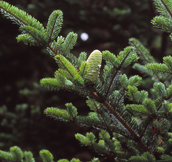
 Abies firma Pinaceae
Abies firma Pinaceae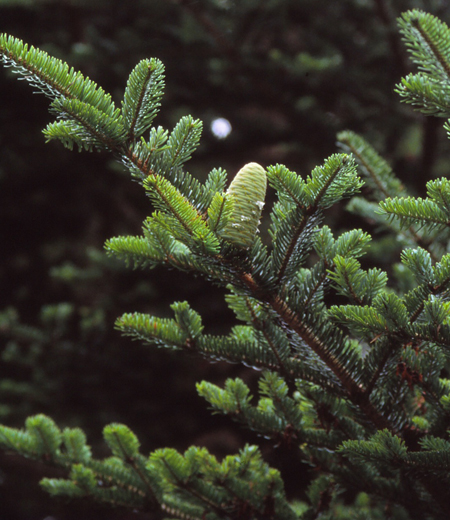 They are a deciduous tall tree that grows wild around hilly district to the mountain areas. Cortex is ash gray color and the one of young trees is smooth feeling to touch, but once grown adult trees the cortex is split scaly. Their characteristic is they grow very rapidly, and are like to go rotten. The trunk grows to be about 1 m wide. They are planted as garden trees, and the wood is utilized for material for building construction as well as the materials to make coffins and a tall, narrow wooden tablet (Sotoba: material of Buddhism, set up behind a grave for the pray for the dead). The leaves are about 2 to 3.5 cm long and thin and long with a flat cross-sectional surface. Usually they have a little dent at the limb, but the leaves of young trees are split into 2. The blossom season is around May and hermaphroditism plant (Shiyuudousyu). Yellow male flowers consist of many male stamens gathering cylindrically on the branch that extended the previous year, while green female flowers sprout beside the leaf of the same tree. The seeds are a circular cylindrical shape alike woodsy pinecone (Matsu-bokkuri), about 10 to 15 cm long. They get matured in October, the year of blossoms, and then fall discretely.
They are a deciduous tall tree that grows wild around hilly district to the mountain areas. Cortex is ash gray color and the one of young trees is smooth feeling to touch, but once grown adult trees the cortex is split scaly. Their characteristic is they grow very rapidly, and are like to go rotten. The trunk grows to be about 1 m wide. They are planted as garden trees, and the wood is utilized for material for building construction as well as the materials to make coffins and a tall, narrow wooden tablet (Sotoba: material of Buddhism, set up behind a grave for the pray for the dead). The leaves are about 2 to 3.5 cm long and thin and long with a flat cross-sectional surface. Usually they have a little dent at the limb, but the leaves of young trees are split into 2. The blossom season is around May and hermaphroditism plant (Shiyuudousyu). Yellow male flowers consist of many male stamens gathering cylindrically on the branch that extended the previous year, while green female flowers sprout beside the leaf of the same tree. The seeds are a circular cylindrical shape alike woodsy pinecone (Matsu-bokkuri), about 10 to 15 cm long. They get matured in October, the year of blossoms, and then fall discretely.
●Height about 25 to 40 m
●Place Trail 3 and 4,Iroha -
Cryptomeria japonica(Japanese Cedar) Taxodiaceae
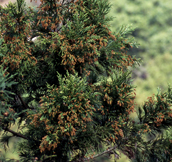
 Cryptomeria japonica(Japanese Cedar) Taxodiaceae
Cryptomeria japonica(Japanese Cedar) Taxodiaceae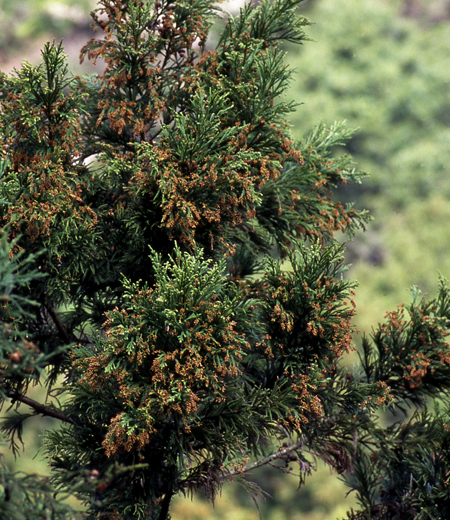 Taxodiaceae
Taxodiaceae
They are an evergreen tree that grows wild along the mountain streams in the mountain areas. As they are utilized as material for building construction, we can see them here and there in Mt. Takao, too. Along Trail 5, ‘EGAWA-Japanese cedar’ is known to people, which was planted by Mr. Tarozaemon EGAWA during Edo era, who was an Edo-period prefectural governor. Cortex is tinged with reddish brown and vertically split as well as slightly peeled off in strips. The trunk grows to be about 1 to 2 m wide. The leaves are a little bit looping acerate about 1 cm long with the sharp top growing in a spiral manner on the branch. The blossom seasons are about March to April and a monoecious plant. Pale yellow male flowers sprout gather like scions on the branch which extended the previous year, while 1 green color female flower sprouts. The seeds are a spherical shape about 2 to 3 cm in diameter with about 30 of brown wooded scale-likes attached.
●Height about 30 to 40 m
●Place Trail 1 to 6, Mt.Inari, Jyataki, Iroha, Ura-Takao, Oku-Takao, Minami- Takao, Kita-Takao -
Chamaecyparis obtura Cupressaceae
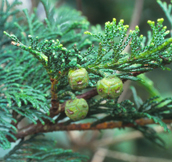
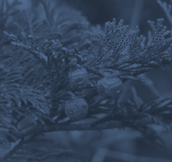 Chamaecyparis obtura Cupressaceae
Chamaecyparis obtura Cupressaceae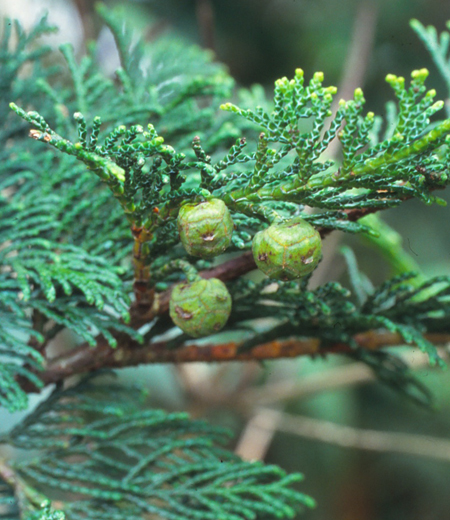 They are an evergreen tree that grows wild at such arid places as at mountainsides and mountain ridges in the mountain areas. As it is the same case with Japanese cedar, they have been planted all over around Japan to be utilized for building materials resources. Cortex is red-brown and widely vertically split to be peeled off. The trunk grows to be about 60 cm wide, while the branch expands thin horizontally. The dense leaves grow gather in a shape of small scale with the common top. They have stomata line (a line of small holes which let the air in and out, and moisture blow off), which is at the back and looks like Y-letter feature. The blossom season is about April and hermaphroditism plant (Shiyuudousyu), which has purplish brown male flowers and female flowers on the limb of the branch. A male flower is elliptically-shaped about 2 to 3 mm long, tinged with red, while female flower is a spherical shape about 3 to 5 mm in diameter. The seeds are a spherical shape about 1 cm in diameter with about 8 to 10 of wooded scale-likes attached. The seeds get matured to red-brown in October to November to let the winged seeds fly away.
They are an evergreen tree that grows wild at such arid places as at mountainsides and mountain ridges in the mountain areas. As it is the same case with Japanese cedar, they have been planted all over around Japan to be utilized for building materials resources. Cortex is red-brown and widely vertically split to be peeled off. The trunk grows to be about 60 cm wide, while the branch expands thin horizontally. The dense leaves grow gather in a shape of small scale with the common top. They have stomata line (a line of small holes which let the air in and out, and moisture blow off), which is at the back and looks like Y-letter feature. The blossom season is about April and hermaphroditism plant (Shiyuudousyu), which has purplish brown male flowers and female flowers on the limb of the branch. A male flower is elliptically-shaped about 2 to 3 mm long, tinged with red, while female flower is a spherical shape about 3 to 5 mm in diameter. The seeds are a spherical shape about 1 cm in diameter with about 8 to 10 of wooded scale-likes attached. The seeds get matured to red-brown in October to November to let the winged seeds fly away.
●Height about 20 to 30 m
●Place Trail 1 to 6, Mt.Inari, Jyataki, Iroha, Ura-Takao, Oku-Takao, Minami-Takao, Kita-Takao -
Quercus serrata Fagaceae
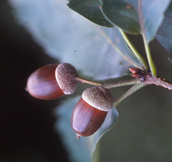
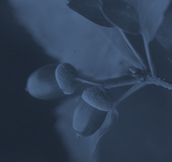 Quercus serrata Fagaceae
Quercus serrata Fagaceae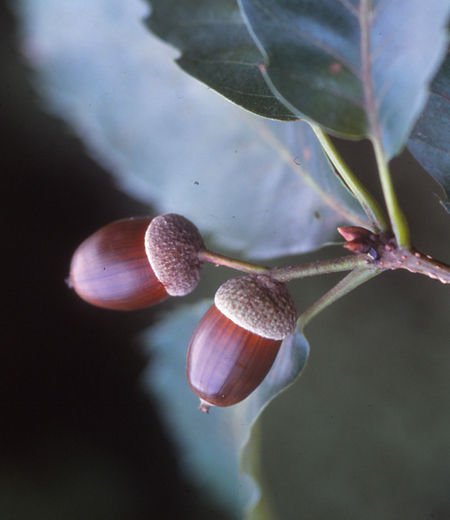 They are a deciduous tall tree that grows wild in the mountain areas. Cortex is greenish-tinged black color and smooth feeling to touch with lenticels in line vertically.
They are a deciduous tall tree that grows wild in the mountain areas. Cortex is greenish-tinged black color and smooth feeling to touch with lenticels in line vertically.
When they grow older, many of them are split vertically shallow and rough feeling to touch. The trunk grows to be about 60 cm wide. They are often planted for garden trees and roadside trees as well as are utilized for material for building construction, for music device and musical instrument material, and raw wood to raise shiitake mushrooms. The leaves are long elliptically-shaped about 5 to 15 cm long with the sharp top and with sawtooth (Kyoshi: tooth-like rough part like a saw at the root of a leaf) at the edge. The leaves are hard feeling to touch and the back is tinged with white. The blossom seasons are around May and hermaphroditism plant (Shiyuudousyu). The spike of thin and long male flower about 2 to 6 cm long sprouts beside the branches that newly grow and extended the previous year dangles, while 3 to 4 of female flowers sprout beside the upper leaf of a new branch. The seeds, ‘acorn’ (Donguri), are egged-shaped about 2 cm long, get matured next autumn.
●Height about 15 to 20 m
●Place Trail 1 to 5, Mt.Inari -
Quercus myrsinaefolia Fagaceae
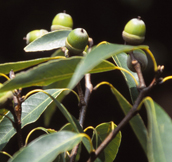
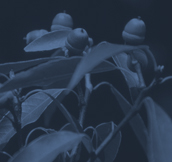 Quercus myrsinaefolia Fagaceae
Quercus myrsinaefolia Fagaceae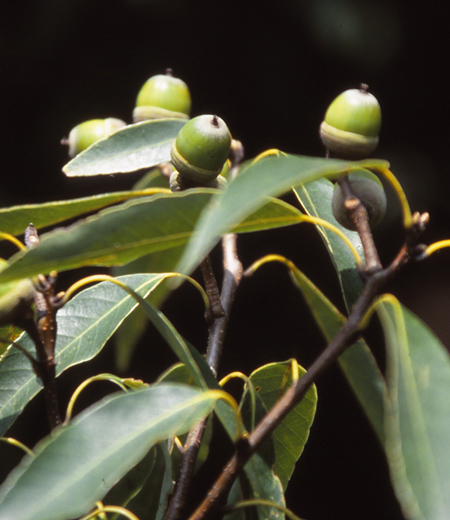 They are a deciduous tall tree that grows wild in the mountain areas. Cortex is greenish-tinged black color and smooth feeling to touch with lenticels in line vertically. When they grow older, many of them are split vertically shallow and rough feeling to touch. The trunk grows to be about 80 cm wide. They are often planted for garden trees and roadside trees as well as are utilized for material for building construction, for music device and musical instrument material, and raw wood to raise shiitake mushrooms. The leaves are long elliptically-shaped about 7 to 14 cm long with the sharp top and with sawtooth (Kyoshi: tooth-like rough part like a saw at the root of a leaf) at the edge. The leaves are hard feeling to touch and the back is tinged with white. The blossom seasons are around May and hermaphroditism plant (Shiyuudousyu). The spike of thin and long male flower about 5 to 12 cm long sprouts beside the branches that newly grow and extended the previous year dangles, while 3 to 4 of female flowers sprout beside the upper leaf of a new branch. The seeds, ‘acorn’ (Donguri), are egged-shaped about 1.5 cm long, get matured next autumn.
They are a deciduous tall tree that grows wild in the mountain areas. Cortex is greenish-tinged black color and smooth feeling to touch with lenticels in line vertically. When they grow older, many of them are split vertically shallow and rough feeling to touch. The trunk grows to be about 80 cm wide. They are often planted for garden trees and roadside trees as well as are utilized for material for building construction, for music device and musical instrument material, and raw wood to raise shiitake mushrooms. The leaves are long elliptically-shaped about 7 to 14 cm long with the sharp top and with sawtooth (Kyoshi: tooth-like rough part like a saw at the root of a leaf) at the edge. The leaves are hard feeling to touch and the back is tinged with white. The blossom seasons are around May and hermaphroditism plant (Shiyuudousyu). The spike of thin and long male flower about 5 to 12 cm long sprouts beside the branches that newly grow and extended the previous year dangles, while 3 to 4 of female flowers sprout beside the upper leaf of a new branch. The seeds, ‘acorn’ (Donguri), are egged-shaped about 1.5 cm long, get matured next autumn.
●Height about 15 to20 m
●Place Trail 1 to 3 -
Castanopsis sieboldii Fagaceae
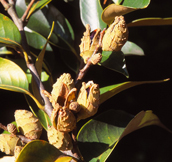
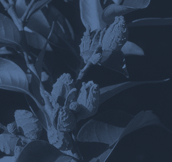 Castanopsis sieboldii Fagaceae
Castanopsis sieboldii Fagaceae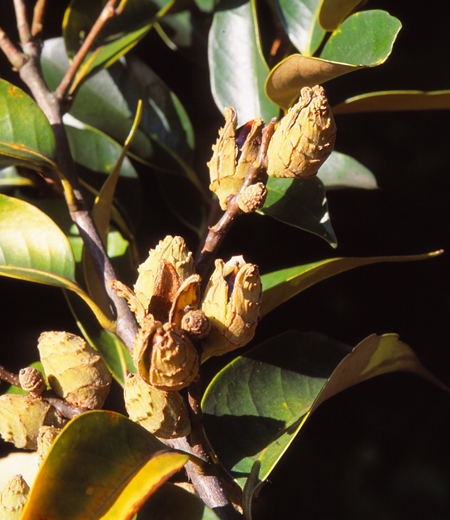 They are a evergreen tall tree that grows wild in the mountain areas, which is called ‘beech tree of genus Castanopsis‘ in general. Cortex is blackish brown color and is vertically split deeper. The trunk grows to be about 1 meter wide. They are often planted for garden trees and windbreak trees as well as are utilized for material for building construction, for furniture and appliance material, and raw wood to raise shiitake mushrooms. The leaves are wide elliptically-shaped about 6 to 15 cm long with a half of the edge bearing sawtooth (Kyoshi: tooth-like rough part like a saw at the root of a leaf) and with the back bearing finely minute trichome. The blossom seasons are about May to June and hermaphroditism plant (Shiyuudousyu). The spike of pale yellowish-tinged male flower about 8 to 12 cm long dangles from a new branch, while several of female flowers sprout beside the leaf at the upper part of the branch. When the flowers are in full bloom, young leaves in yellow color show up like growing thick and strong odor can be smelled. The seeds, ‘acorn’ (Donguri), are elliptically-shaped about 2 cm long, get matured next autumn, and then can be edible.
They are a evergreen tall tree that grows wild in the mountain areas, which is called ‘beech tree of genus Castanopsis‘ in general. Cortex is blackish brown color and is vertically split deeper. The trunk grows to be about 1 meter wide. They are often planted for garden trees and windbreak trees as well as are utilized for material for building construction, for furniture and appliance material, and raw wood to raise shiitake mushrooms. The leaves are wide elliptically-shaped about 6 to 15 cm long with a half of the edge bearing sawtooth (Kyoshi: tooth-like rough part like a saw at the root of a leaf) and with the back bearing finely minute trichome. The blossom seasons are about May to June and hermaphroditism plant (Shiyuudousyu). The spike of pale yellowish-tinged male flower about 8 to 12 cm long dangles from a new branch, while several of female flowers sprout beside the leaf at the upper part of the branch. When the flowers are in full bloom, young leaves in yellow color show up like growing thick and strong odor can be smelled. The seeds, ‘acorn’ (Donguri), are elliptically-shaped about 2 cm long, get matured next autumn, and then can be edible.
●Height about 20 to 30 m
●Place Trail 1 to 3 -
Euptelea polyandra Eupteleaceae
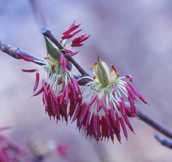
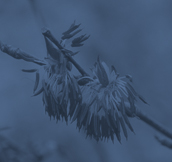 Euptelea polyandra Eupteleaceae
Euptelea polyandra Eupteleaceae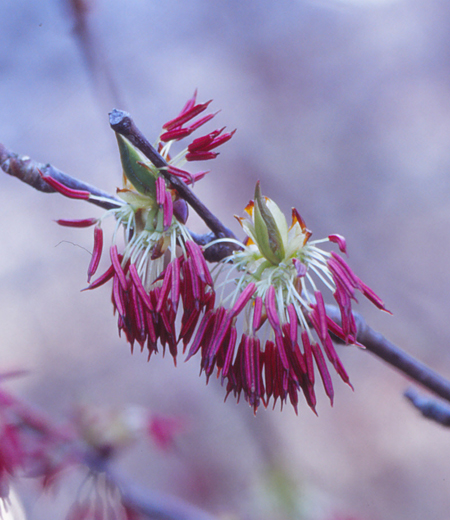 Deciduous small trees found in wet areas including streamside in mountains. Barks are bright brown and smooth. Trunk grows up to 30 cm. Wide and long lenticels (an opening that allows gases to be exchanged between air and the inner tissues of a plant) are distinct on young tree. It cracks to become net-like appearance for old trees. Is similar to cherry blossoms but they are not in the same group. Leaves are 6 to 12 cm long and round shaped with tips extended and whitish on the back. The blooming season is from March to April and bloom five to twelve dark red flowers at the tips of branches before leaves open. Have no petals or calyx and many stamens about 7 mm long are dropping and have pistils at the base. Fruits are odd-shaped and dropping on fruits stems. Turn yellow in autumn and seeds are flown by the wind.
Deciduous small trees found in wet areas including streamside in mountains. Barks are bright brown and smooth. Trunk grows up to 30 cm. Wide and long lenticels (an opening that allows gases to be exchanged between air and the inner tissues of a plant) are distinct on young tree. It cracks to become net-like appearance for old trees. Is similar to cherry blossoms but they are not in the same group. Leaves are 6 to 12 cm long and round shaped with tips extended and whitish on the back. The blooming season is from March to April and bloom five to twelve dark red flowers at the tips of branches before leaves open. Have no petals or calyx and many stamens about 7 mm long are dropping and have pistils at the base. Fruits are odd-shaped and dropping on fruits stems. Turn yellow in autumn and seeds are flown by the wind.
●Height about 5 to 15 m
●Place Trail 4, Jyataki, Oku-Takao -
Magnolia hypoleuca Magnoliaceae
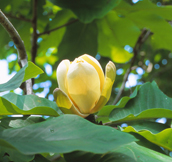
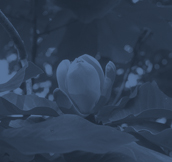 Magnolia hypoleuca Magnoliaceae
Magnolia hypoleuca Magnoliaceae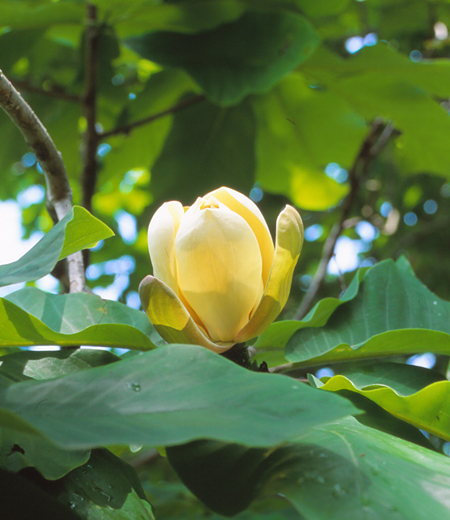 They are a deciduous tall tree that grows wild around hilly district to the mountain areas. Cortex is smooth feeling to touch and gray color with many small lenticels. The trunk grows to be about 1 m wide. The wood is so accurate that it is utilized to make for house furnishings and wooden clogs. The leaves are large, about 20 to 40 cm long, about 10 to 25 cm wide, long elliptically-shaped like an inverted egg, and thick and hard. The leaves are also called ‘Hooba’ (leaves used for ocal cuisines at Hida Takayama region, Gifu Prefecture) and people have used them to wrap the food and as dishes instead of plates since decades ago. The flowers are also large about 15 cm long, white flowers tinged with yellow blossom upwards at the limb in May to June. Their sweet smell is so strong that people around them can enjoy it. The seeds are aggregate fruit (Syugo-ka) which consists of many small seedlings, long elliptically-shaped, and about 10 to 15 cm long. When each of the seeds get matured, they are split to shoot 2 red seedlings.
They are a deciduous tall tree that grows wild around hilly district to the mountain areas. Cortex is smooth feeling to touch and gray color with many small lenticels. The trunk grows to be about 1 m wide. The wood is so accurate that it is utilized to make for house furnishings and wooden clogs. The leaves are large, about 20 to 40 cm long, about 10 to 25 cm wide, long elliptically-shaped like an inverted egg, and thick and hard. The leaves are also called ‘Hooba’ (leaves used for ocal cuisines at Hida Takayama region, Gifu Prefecture) and people have used them to wrap the food and as dishes instead of plates since decades ago. The flowers are also large about 15 cm long, white flowers tinged with yellow blossom upwards at the limb in May to June. Their sweet smell is so strong that people around them can enjoy it. The seeds are aggregate fruit (Syugo-ka) which consists of many small seedlings, long elliptically-shaped, and about 10 to 15 cm long. When each of the seeds get matured, they are split to shoot 2 red seedlings.
●Height about 20 to 30 m
●Place Trail 4, Mt.Inari, Oku-Takao -
Lindera praecox Lauraceae

 Lindera praecox Lauraceae
Lindera praecox Lauraceae They are a deciduous small trees or shrubs that grow wild through mountains and fields. They grow like bushy and mostly we can see them auch a humid places as along the mountain strams. Cortex is tinged with gray-brown and small round lenticel show off. The characteristic o the tree is tough and strong, therefore, people used to utilize thie tree as a substitute for sticks and round or lattice-type snowshoes that are made of bamboo. A part of the name ‘Chan’ means ‘bituminous rock’ (Rekisei: substances such as natural tar) and entirely contains oils, so that in ancient times people use this oils extracted from the seeds and cortex for lighting. This is how they are named. The leaves are elliptically-shaped about 4 to 9 cm long, about 2 to 4 cm wide with the sharp topand the leafstalk is tinged with red. The blossom seasons are about March to April and a dioecious plant (Shiyuuisyu). They bear 3 to 5 f small yellow flowers on the branch that extended the previous year. Both a male flower and a female flower have 6 flower petals each, about 2 mm long. The seeds that are in a spherical shape about 1.5 cm in diameter get matured to yellowish brown in September to October.
They are a deciduous small trees or shrubs that grow wild through mountains and fields. They grow like bushy and mostly we can see them auch a humid places as along the mountain strams. Cortex is tinged with gray-brown and small round lenticel show off. The characteristic o the tree is tough and strong, therefore, people used to utilize thie tree as a substitute for sticks and round or lattice-type snowshoes that are made of bamboo. A part of the name ‘Chan’ means ‘bituminous rock’ (Rekisei: substances such as natural tar) and entirely contains oils, so that in ancient times people use this oils extracted from the seeds and cortex for lighting. This is how they are named. The leaves are elliptically-shaped about 4 to 9 cm long, about 2 to 4 cm wide with the sharp topand the leafstalk is tinged with red. The blossom seasons are about March to April and a dioecious plant (Shiyuuisyu). They bear 3 to 5 f small yellow flowers on the branch that extended the previous year. Both a male flower and a female flower have 6 flower petals each, about 2 mm long. The seeds that are in a spherical shape about 1.5 cm in diameter get matured to yellowish brown in September to October.
●Height about 3 to 6 m
●Place Trail 1, Trail 3 to 6, Mt.Inari, Ura-Takao, Minami-Takao -
Lindera obtusiloba Lauraceae
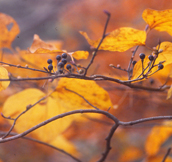
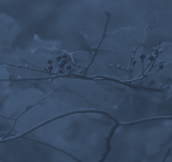 Lindera obtusiloba Lauraceae
Lindera obtusiloba Lauraceae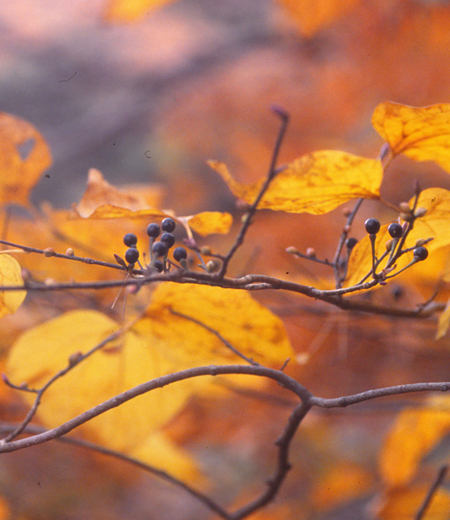 They are deciduous small trees or shrubs that grow wild in the pool of grove of mixed trees at the mountain areas. Cortex is tinged with gray and has lots of round lenticel, and the trunk grows to be about 18 cm wide. Young trees have yellowish green soft dense trichome, but later this trichome disappears and instead, turns into cadet brownish yellow. The leaves are wide egged-shaped about 5 to 15 cm long. It is usual that the top is split into 3 like shallow mound, but that some are not. The leaves turn into vivid yellow in autumn. The blossom, seasons are about March to April, and a dioecious plant (Shiyuuisyu). Yellow flowers with good smell bloom on the tree that extended the previous year before the leaves are open. They are known as one of the flowers that blossom, early spring at Mt. Takao, and have another name according to the flower color; ‘Benzoin obtusilobum’, The seeds are a spherical shape about 8 mm in diameters, and at first they are red, but later get matured to black in September to October.
They are deciduous small trees or shrubs that grow wild in the pool of grove of mixed trees at the mountain areas. Cortex is tinged with gray and has lots of round lenticel, and the trunk grows to be about 18 cm wide. Young trees have yellowish green soft dense trichome, but later this trichome disappears and instead, turns into cadet brownish yellow. The leaves are wide egged-shaped about 5 to 15 cm long. It is usual that the top is split into 3 like shallow mound, but that some are not. The leaves turn into vivid yellow in autumn. The blossom, seasons are about March to April, and a dioecious plant (Shiyuuisyu). Yellow flowers with good smell bloom on the tree that extended the previous year before the leaves are open. They are known as one of the flowers that blossom, early spring at Mt. Takao, and have another name according to the flower color; ‘Benzoin obtusilobum’, The seeds are a spherical shape about 8 mm in diameters, and at first they are red, but later get matured to black in September to October.
●Height about 2 to 6 m
●Place Trail 5,Ura-Takao, Oku-Takao, Minami-Takao -
Hydrangea scandens Saxifragaceae
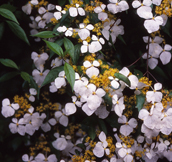
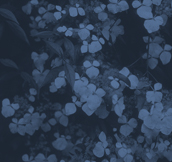 Hydrangea scandens Saxifragaceae
Hydrangea scandens Saxifragaceae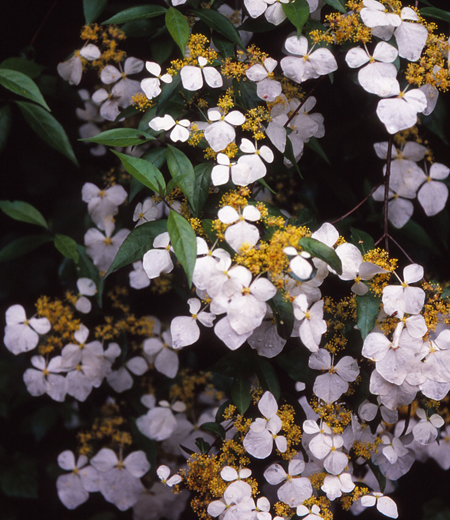 Deciduous shrubs found on slopes and at forest edges on streamside. Grow by extending many branches. Barks are dark gray and smooth. Young branches are brown with hair but turns grayish-white on the following year. Flowers resemble hydrangea and trees resemble deutzia crenata, hence the Japanese name Gaku-utsugi literally meaning hydrangea deutzia crenata. Leaves are 4 to 7 cm long, elongated oval-shaped and opposite. Tips are pointed, texture is shiny and have toothed margins (edges of leaves are like a teeth of saw). Another name is kon-teri-gi literally meang dark blue shine tree was named because the plant looks dark blue and reflects metallic shine. The blooming season is from May to June. Bloom light yellow-green flowers on 7 to 10 cm long inflorescence grow from branches. 2.5 to 3 cm long and white (surround inflorescence have no stamen or pistills) surround this flower.
Deciduous shrubs found on slopes and at forest edges on streamside. Grow by extending many branches. Barks are dark gray and smooth. Young branches are brown with hair but turns grayish-white on the following year. Flowers resemble hydrangea and trees resemble deutzia crenata, hence the Japanese name Gaku-utsugi literally meaning hydrangea deutzia crenata. Leaves are 4 to 7 cm long, elongated oval-shaped and opposite. Tips are pointed, texture is shiny and have toothed margins (edges of leaves are like a teeth of saw). Another name is kon-teri-gi literally meang dark blue shine tree was named because the plant looks dark blue and reflects metallic shine. The blooming season is from May to June. Bloom light yellow-green flowers on 7 to 10 cm long inflorescence grow from branches. 2.5 to 3 cm long and white (surround inflorescence have no stamen or pistills) surround this flower.
●Height about 1 to 1.5 m
●Place Trail 4, Trail 6 -
Deutzia scabra Saxifragaceae
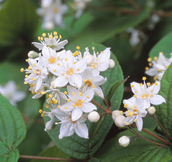
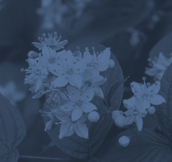 Deutzia scabra Saxifragaceae
Deutzia scabra Saxifragaceae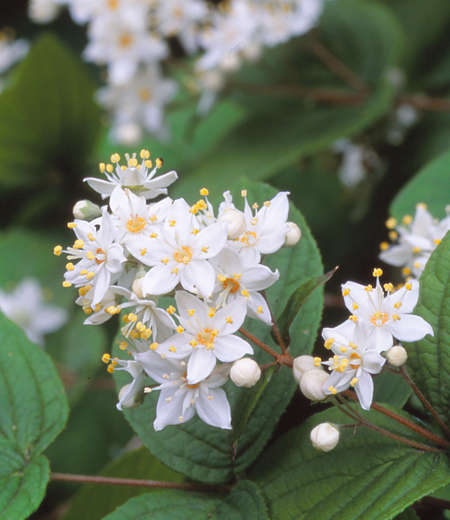 Deciduous shrubs found in sunny and dry slopes in mountains. Barks are grayish-brown and peel like strips of papers and have hollow inside the branch. Young branches are purplish brown with hair. Leaves are 4 to 7 cm long, egg-shaped and lower parts of leaves covering stems. Have hair on both sides with toothed margins (edges of leaves are like a teeth of saw). The Japanese name Maruba-utsugi was named because this plants have round-shaped leaves in Deutzia crenata (Utsugi). In autumn, leaves turn to purplish-brown. The blooming season is May. Bloom white flowers facing upward on cylindrical inflorescence (flower stems) grow from petioles. Flowers are 1.5 cm in diameter, star-shaped and five petals are with yellow flower disks (support petals). After flowering, bear hairy spherical fruits, 3 mm in diameter.
Deciduous shrubs found in sunny and dry slopes in mountains. Barks are grayish-brown and peel like strips of papers and have hollow inside the branch. Young branches are purplish brown with hair. Leaves are 4 to 7 cm long, egg-shaped and lower parts of leaves covering stems. Have hair on both sides with toothed margins (edges of leaves are like a teeth of saw). The Japanese name Maruba-utsugi was named because this plants have round-shaped leaves in Deutzia crenata (Utsugi). In autumn, leaves turn to purplish-brown. The blooming season is May. Bloom white flowers facing upward on cylindrical inflorescence (flower stems) grow from petioles. Flowers are 1.5 cm in diameter, star-shaped and five petals are with yellow flower disks (support petals). After flowering, bear hairy spherical fruits, 3 mm in diameter.
●Height about 1 to 1.5 m
●Place Trail 5 and 6 -
Hydrangea involucrata Saxifragaceae
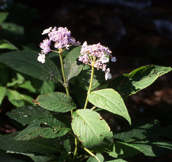
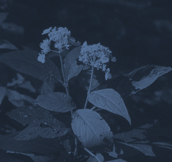 Hydrangea involucrata Saxifragaceae
Hydrangea involucrata Saxifragaceae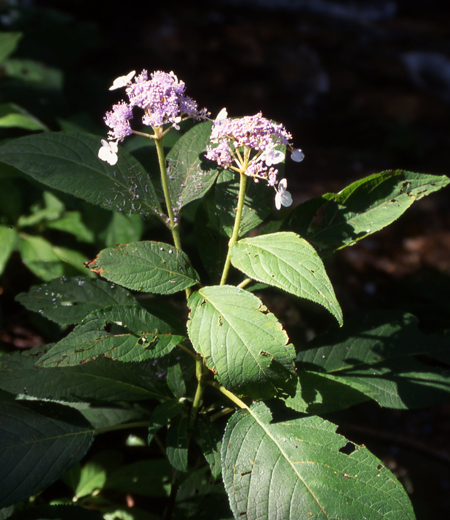 Deciduous shrubs found in wet streamside and forest edges in mountains. Grow by extending branches. Young branches have hairs densely placed. Leaves are 10 to 20 cm long, oval-shaped and opposite. Have pointed tip with toothed margins (edges of leaves are like a teeth of saw). Also have rough hairs on both sides and rough at a touch. The Japanese name Tama-ajisai literally meaning spherical hydrangea was named because spherical buds are striking. The blooming season is from April to September and start blooming after rainy season is over. Inflorescence (flower stems) are 3 cm in diameter spherical-shaped covered with flower disks. And then, this flower disks fell apart and bloom light bue small flowers and three to five white ornamental (surround inflorescence have no stamen or pistills). Fruits are 3.5 mm long egg-shaped with pistil remain at tips.
Deciduous shrubs found in wet streamside and forest edges in mountains. Grow by extending branches. Young branches have hairs densely placed. Leaves are 10 to 20 cm long, oval-shaped and opposite. Have pointed tip with toothed margins (edges of leaves are like a teeth of saw). Also have rough hairs on both sides and rough at a touch. The Japanese name Tama-ajisai literally meaning spherical hydrangea was named because spherical buds are striking. The blooming season is from April to September and start blooming after rainy season is over. Inflorescence (flower stems) are 3 cm in diameter spherical-shaped covered with flower disks. And then, this flower disks fell apart and bloom light bue small flowers and three to five white ornamental (surround inflorescence have no stamen or pistills). Fruits are 3.5 mm long egg-shaped with pistil remain at tips.
●Height about 1 to 2 m
●Place Trail 1 and 2,Trail 4 to 6,Ura-Takao, Oku-Takao, Minami-Takao -
Rubus palmatus var. coptophyllus Rosaceae
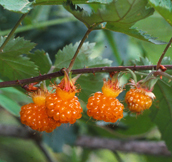
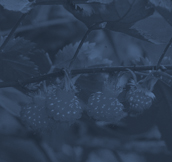 Rubus palmatus var. coptophyllus Rosaceae
Rubus palmatus var. coptophyllus Rosaceae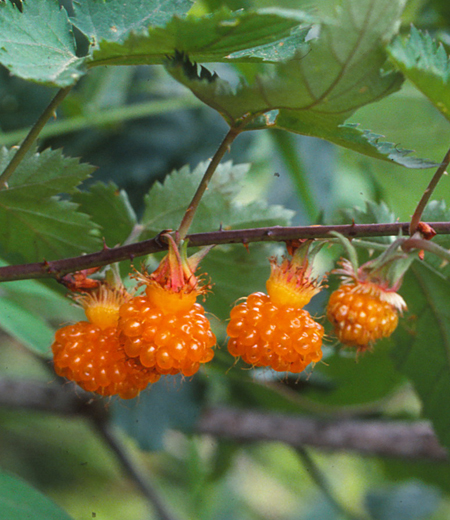 Deciduous shrubs found in sunny bright forest edges in mountains of Eastern Japan. Barks of young tree are bright green and turns to brown for adults. Have spines on branches and petioles (leaf stems). Have many branches. The Japanese name Momiji-ichigo literally meaning maple strawberry was named because the leaves resemble maple leaves. Leaves are 7 to 15 cm long in diameter and pinnate in three to five like palms. Petioles are long and leaves alternate with toothed margins (edges of leaves are like a teeth of saw). Leaves turn yellow in autumn. The blooming season is from March to May and bloom one white dropping flower and 3 cm in diameter on the branch grew on the previous year. Five petals are wide oval-shaped. Calyx has sharp tip. Fruits are 1 to 1.5 cm diameter collective flowers and turn orange as they ripen from June to July and edible.
Deciduous shrubs found in sunny bright forest edges in mountains of Eastern Japan. Barks of young tree are bright green and turns to brown for adults. Have spines on branches and petioles (leaf stems). Have many branches. The Japanese name Momiji-ichigo literally meaning maple strawberry was named because the leaves resemble maple leaves. Leaves are 7 to 15 cm long in diameter and pinnate in three to five like palms. Petioles are long and leaves alternate with toothed margins (edges of leaves are like a teeth of saw). Leaves turn yellow in autumn. The blooming season is from March to May and bloom one white dropping flower and 3 cm in diameter on the branch grew on the previous year. Five petals are wide oval-shaped. Calyx has sharp tip. Fruits are 1 to 1.5 cm diameter collective flowers and turn orange as they ripen from June to July and edible.
●Height about 1 to 2 m
●Place Trail 1, Trail 3 to 6, Mt.Inari, Minami-Takao -
Caesalpinia decapetala var. japonica Leguminosae
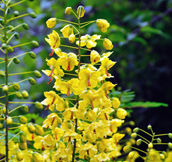
 Caesalpinia decapetala var. japonica Leguminosae
Caesalpinia decapetala var. japonica Leguminosae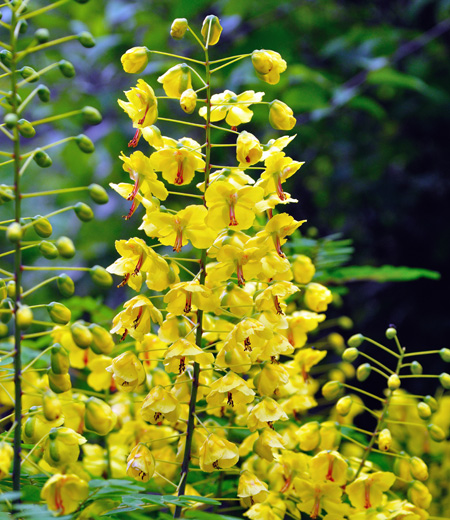 Deciduous woody vines (vines that sheds its leaves once in a year) found in forest edges at streamside in mountains. Branches grow like vines with many spines. Tangled branches resembling snakes, hence the Japanese name Jyaketsu-ibara literally meaning snake tied brambles. Oval-shaped leaflets (leaf-like parts of compound leaves) are in five to ten pairs and 20 to 40 cm long. The blooming season is from May to June, and has 20 to 30 cm long inflorescence on a branch and blooms many yellow flowers. Flowers are 3 cm in diameter and five petals. One petal is small with red spots. After flowering, bears 10 cm long, 3 cm width and shell-shaped. Turn brown as they ripen and crack in two and pop about 10 seeds. Seeds are about 1 cm oval-shaped and black.
Deciduous woody vines (vines that sheds its leaves once in a year) found in forest edges at streamside in mountains. Branches grow like vines with many spines. Tangled branches resembling snakes, hence the Japanese name Jyaketsu-ibara literally meaning snake tied brambles. Oval-shaped leaflets (leaf-like parts of compound leaves) are in five to ten pairs and 20 to 40 cm long. The blooming season is from May to June, and has 20 to 30 cm long inflorescence on a branch and blooms many yellow flowers. Flowers are 3 cm in diameter and five petals. One petal is small with red spots. After flowering, bears 10 cm long, 3 cm width and shell-shaped. Turn brown as they ripen and crack in two and pop about 10 seeds. Seeds are about 1 cm oval-shaped and black.
●Height Vines
●Place Jyataki -
Skimmia japonica Rutaceae
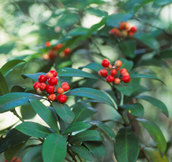
 Skimmia japonica Rutaceae
Skimmia japonica Rutaceae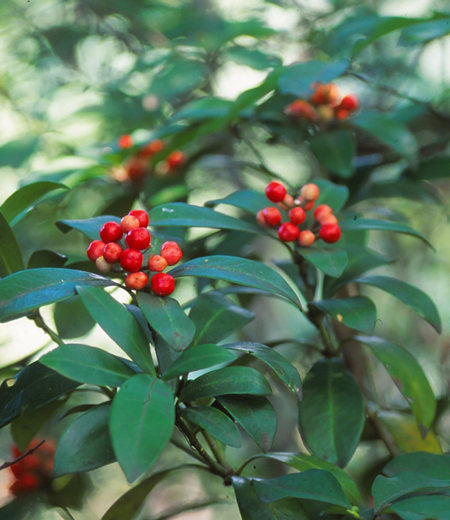 Evergreen shrubs (less than 1 m tall tree with green leaves throughout a year) found in forests in mountains. In Mt. Takao, found in fir tree forests near mountain ridges. Grow in mountain and braches and leaves resemble skimmia, hence the Japanese name Miyama-sikimi literally meaning deep in the mountain skimmia. Leaves are 4 to 9 cm long, 3 to 5 cm width, oval shaped and mostly at the tips of stems. Texture is leathery with shiny surface and leaf glands (small glands to release secretion) are placed irregularly. The blooming season is March to May and have male and female flowers. Bloom 1 cm in diameter white flowers densely on inflorescence grows from petioles. After flowering, bear 5 to 8 mm spherical shaped fruits and have one seed inside. Turn shiny red as they ripen. The entire plant has poisonous ingredients called skimmianine and is contained in fruits the most. Cause cramps when eaten by mistake.
Evergreen shrubs (less than 1 m tall tree with green leaves throughout a year) found in forests in mountains. In Mt. Takao, found in fir tree forests near mountain ridges. Grow in mountain and braches and leaves resemble skimmia, hence the Japanese name Miyama-sikimi literally meaning deep in the mountain skimmia. Leaves are 4 to 9 cm long, 3 to 5 cm width, oval shaped and mostly at the tips of stems. Texture is leathery with shiny surface and leaf glands (small glands to release secretion) are placed irregularly. The blooming season is March to May and have male and female flowers. Bloom 1 cm in diameter white flowers densely on inflorescence grows from petioles. After flowering, bear 5 to 8 mm spherical shaped fruits and have one seed inside. Turn shiny red as they ripen. The entire plant has poisonous ingredients called skimmianine and is contained in fruits the most. Cause cramps when eaten by mistake.
●Height about 1 to 1.5m
●Place Trail 1, Trail 3 and 4, Mt.Inari -
Mallotus japonicus Euphorbiaceae
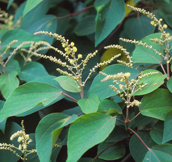
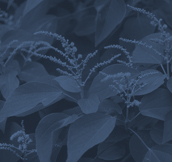 Mallotus japonicus Euphorbiaceae
Mallotus japonicus Euphorbiaceae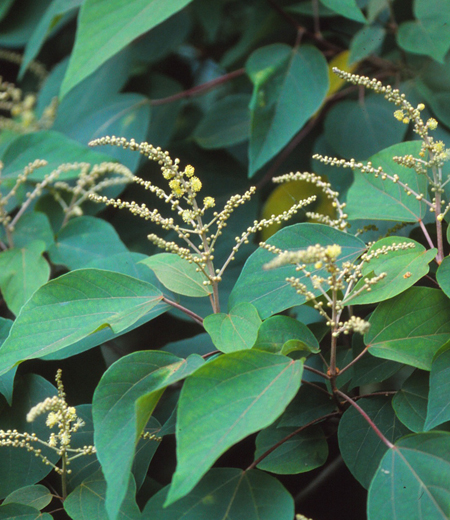 Deciduous shrubs found at roadside and forest edges in mountains. The Japanese name have rees found in sunny forest edges and deforested areas in mountains. Barks of young tree are grayish-brown with fine lines and it becomes net-like pattern for adults tree. Trunk grows up to about 50 cm thick. Leaves are 7 to 20 cm long and wide oval-shaped. Have long petioles and alternate. Young leaves have red hair densely placed and used to wrap foods like daimyo oak, hence the Japanese name Akame-gashiwa literally meaning red sprout daimyo oak. The blooming season is from June to July. Male flowers and female flowers are on the different stems with no petals. Male flowers are 7 to 20 cm long inflorescence (flowers on a stem) and bloom with yellow stamens. Female flowers have short inflorescence with red pistils. Fruits are 8 mm in diameter, oval-shaped and turn brown as they ripen from September to October.
Deciduous shrubs found at roadside and forest edges in mountains. The Japanese name have rees found in sunny forest edges and deforested areas in mountains. Barks of young tree are grayish-brown with fine lines and it becomes net-like pattern for adults tree. Trunk grows up to about 50 cm thick. Leaves are 7 to 20 cm long and wide oval-shaped. Have long petioles and alternate. Young leaves have red hair densely placed and used to wrap foods like daimyo oak, hence the Japanese name Akame-gashiwa literally meaning red sprout daimyo oak. The blooming season is from June to July. Male flowers and female flowers are on the different stems with no petals. Male flowers are 7 to 20 cm long inflorescence (flowers on a stem) and bloom with yellow stamens. Female flowers have short inflorescence with red pistils. Fruits are 8 mm in diameter, oval-shaped and turn brown as they ripen from September to October.
●Height about 5 to 15 m
●Place Trail 1 -
Acer palmatum(Japanese maple) Aceraceae
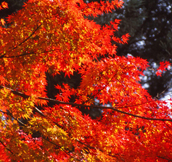
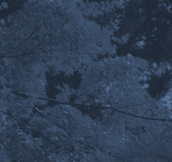 Acer palmatum(Japanese maple) Aceraceae
Acer palmatum(Japanese maple) Aceraceae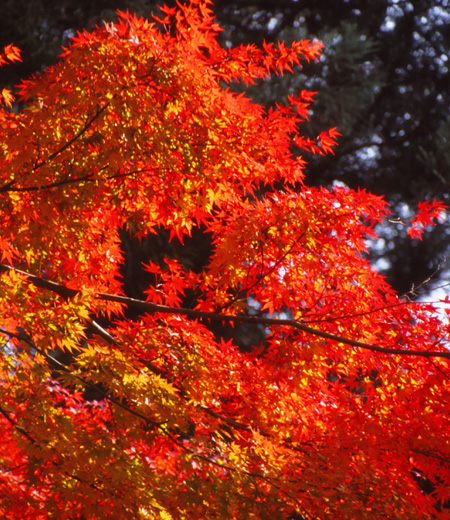 They are a deciduous tall tree that grows wild at the sunny slanting surfaces in the mountain area and at humid places along the mountain streams. They are also utilized for garden trees, park trees, and Bonsai, therefore, also called ‘Acer palmatum Thunberg’ or ‘Acer palmatum’. Cortex of young trees is tinged green and smooth feeling to touch, while adult trees turn into gray color and are split vertically. The trunk is about 60 cm wide. The leaves are split into 5 to 7 like our padded palm, and then people use the split portions to count. This is the reason for the name. Autumn leaves of Aceraceae plant vary like red, yellow, orange, and brown colors with much variation. Acer palmatum in the woods has the leaves with their tip red due to sunshine and yellow inside. The blossom seasons are about April to May. As they are monoecious trees, red flowers blossom at the top of the branch
They are a deciduous tall tree that grows wild at the sunny slanting surfaces in the mountain area and at humid places along the mountain streams. They are also utilized for garden trees, park trees, and Bonsai, therefore, also called ‘Acer palmatum Thunberg’ or ‘Acer palmatum’. Cortex of young trees is tinged green and smooth feeling to touch, while adult trees turn into gray color and are split vertically. The trunk is about 60 cm wide. The leaves are split into 5 to 7 like our padded palm, and then people use the split portions to count. This is the reason for the name. Autumn leaves of Aceraceae plant vary like red, yellow, orange, and brown colors with much variation. Acer palmatum in the woods has the leaves with their tip red due to sunshine and yellow inside. The blossom seasons are about April to May. As they are monoecious trees, red flowers blossom at the top of the branch
●Height about 10 to 20 m
●Place Trail 1 to 4 -
Cercidiphyllum japonicum Cercidiphyllaceae
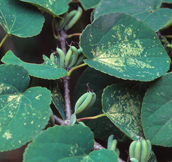
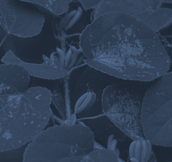 Cercidiphyllum japonicum Cercidiphyllaceae
Cercidiphyllum japonicum Cercidiphyllaceae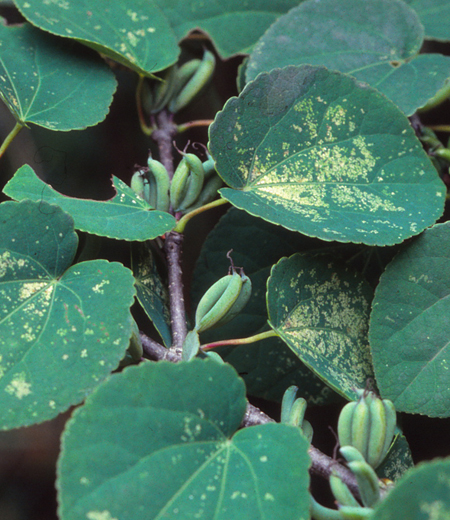 They are a deciduous tall tree that grows wild along the humid valley in the mountain area and smell sweet. Cortex of their young trees is tinged with reddish brown and smooth, while the one of their adult trees turn into dark gray-brown with the trunk being about 2 m wide. As for old trees, they are split shallow vertically and cortex is finely peeled off. The leaf is round heart-shaped about 3 to 8 cm long with a dull gyrose sawtooth at the edge (sawtooth: Kyoshi, serrated edges like a saw- serrated edges at the tip of a leaf) and with the back in white like being flour-coated. The blossom seasons are about March to May and a dioecious plant (Shiyuuisyu). The flower blossoms with no flower petals or sepals before the leaves sprout. A male flower has lots of male stamen tinged with red-purple about 4 mm long, while a female flower bears 3 to 4 of a female stamen tinged with pale showy pink. The seeds are shaped like a banana rolled backward about 1.5 cm long. They get matured into black-purple color in autumn.
They are a deciduous tall tree that grows wild along the humid valley in the mountain area and smell sweet. Cortex of their young trees is tinged with reddish brown and smooth, while the one of their adult trees turn into dark gray-brown with the trunk being about 2 m wide. As for old trees, they are split shallow vertically and cortex is finely peeled off. The leaf is round heart-shaped about 3 to 8 cm long with a dull gyrose sawtooth at the edge (sawtooth: Kyoshi, serrated edges like a saw- serrated edges at the tip of a leaf) and with the back in white like being flour-coated. The blossom seasons are about March to May and a dioecious plant (Shiyuuisyu). The flower blossoms with no flower petals or sepals before the leaves sprout. A male flower has lots of male stamen tinged with red-purple about 4 mm long, while a female flower bears 3 to 4 of a female stamen tinged with pale showy pink. The seeds are shaped like a banana rolled backward about 1.5 cm long. They get matured into black-purple color in autumn.
●Height about 20 to 30 m
●Place Trail 1 to 4, Trail 6, Ura-Takao -
Cleyera japonica Theaceae
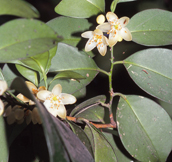
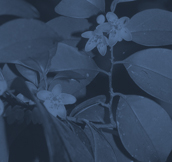 Cleyera japonica Theaceae
Cleyera japonica Theaceae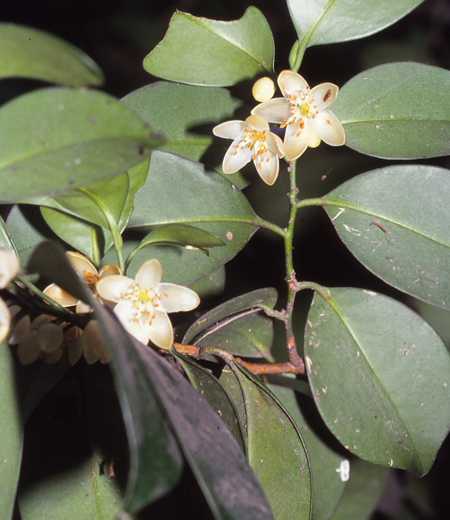 They are an evergreen tree that grows wild in the mountain areas. Cortex is tinged with dark red-brown color and smooth feeling to touch with many small rounded lenticels. Th trunk grows to be about 30 centimeters long. New branches are green and winter buds sprouting from the limb are curved widely like a hook shape. The branches and leaves are utilized to produce a branch of the sacred tree (Tamagushi: one of ritual articles made of branch of a sacred tree (esp. sakaki) with paper or cotton strips attached), and therefore are indispensable trees to shrine rituals, which this is why they are frequently planted at Shinto shrines. The leaves are tall elliptically-shaped about 8 to 10 cm long, about 2 to 4 cm wide, thick and shiny. The blossom seasons are about June to July, when 1 to 3 of the flowers about 1.5 cm in diameter beside the leaf bloom downwards. They bear 5 flower petals, which are white color at first and then later, are tinged with yellow. The seeds are a spherical shape about 7 mm in diameter with male stamen’ styles remaining at the top. The seeds are green color at first and when they get matured in November and December, they are tinged with a black-purple.
They are an evergreen tree that grows wild in the mountain areas. Cortex is tinged with dark red-brown color and smooth feeling to touch with many small rounded lenticels. Th trunk grows to be about 30 centimeters long. New branches are green and winter buds sprouting from the limb are curved widely like a hook shape. The branches and leaves are utilized to produce a branch of the sacred tree (Tamagushi: one of ritual articles made of branch of a sacred tree (esp. sakaki) with paper or cotton strips attached), and therefore are indispensable trees to shrine rituals, which this is why they are frequently planted at Shinto shrines. The leaves are tall elliptically-shaped about 8 to 10 cm long, about 2 to 4 cm wide, thick and shiny. The blossom seasons are about June to July, when 1 to 3 of the flowers about 1.5 cm in diameter beside the leaf bloom downwards. They bear 5 flower petals, which are white color at first and then later, are tinged with yellow. The seeds are a spherical shape about 7 mm in diameter with male stamen’ styles remaining at the top. The seeds are green color at first and when they get matured in November and December, they are tinged with a black-purple.
●Height about 10 to 12 m
●Place Trail 1 to 3 -
Stachyurus praecox Stachyuraceae
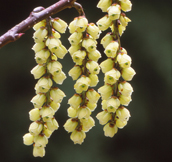
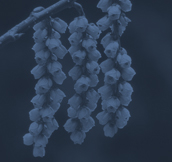 Stachyurus praecox Stachyuraceae
Stachyurus praecox Stachyuraceae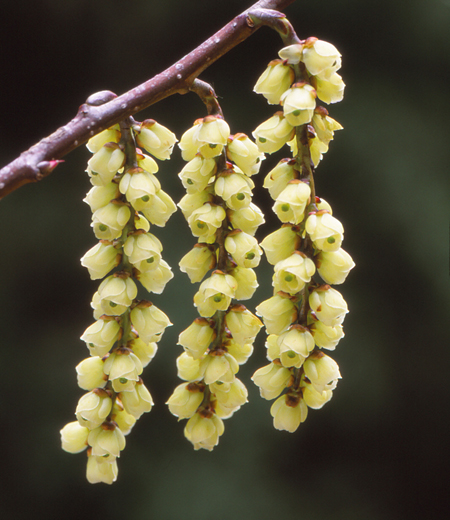 They are a deciduous shrub that grows wild in the forests in mountain areas. Cortex is tinged with dark brown and adult trees get shriveled vertically. The branches that extend are tinged with reddish green and slightly shiny. The leaves are egged-shaped about 6 to 12 cm long, about 3 to 6 cm wide with the sharp top as well as with a sawtooth (sawtooth: Kyoshi, serrated edges like a saw serrated edges at the tip of a leaf). The blossom seasons are about March to April and a dioecious plant (Shiyuuisyu). Before the leaves shoot, they sprout inflorescence (Kajo: stalk blooming flowers) about 4 to 10 cm to dangle white many hanging bell-shaped flowers about 8 mm long. Male flowers are inged with yellow, and female flowers are yellowish green. The seeds are elliptically-shaped spherical form tinged with indigo blue about 8 mm long. The seeds turn to green from yellow to get matured about in July to October. The reason for their name is that people use these seeds as a substitute for sumac gallnut (Fushi: gallnut of Japanese sumac) to make black colorant. This is why they are named ‘Stachyurus praecox’ (Kibushi).
They are a deciduous shrub that grows wild in the forests in mountain areas. Cortex is tinged with dark brown and adult trees get shriveled vertically. The branches that extend are tinged with reddish green and slightly shiny. The leaves are egged-shaped about 6 to 12 cm long, about 3 to 6 cm wide with the sharp top as well as with a sawtooth (sawtooth: Kyoshi, serrated edges like a saw serrated edges at the tip of a leaf). The blossom seasons are about March to April and a dioecious plant (Shiyuuisyu). Before the leaves shoot, they sprout inflorescence (Kajo: stalk blooming flowers) about 4 to 10 cm to dangle white many hanging bell-shaped flowers about 8 mm long. Male flowers are inged with yellow, and female flowers are yellowish green. The seeds are elliptically-shaped spherical form tinged with indigo blue about 8 mm long. The seeds turn to green from yellow to get matured about in July to October. The reason for their name is that people use these seeds as a substitute for sumac gallnut (Fushi: gallnut of Japanese sumac) to make black colorant. This is why they are named ‘Stachyurus praecox’ (Kibushi).
●Height about 3 to 5 m
●Place Trail 1, Trail 5, Ura-Takao, Oku-Takao, Minami-Takao -
Helwingia japonica Cornaceae
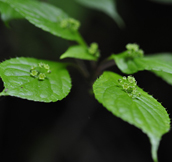
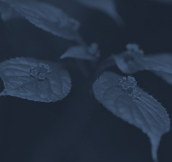 Helwingia japonica Cornaceae
Helwingia japonica Cornaceae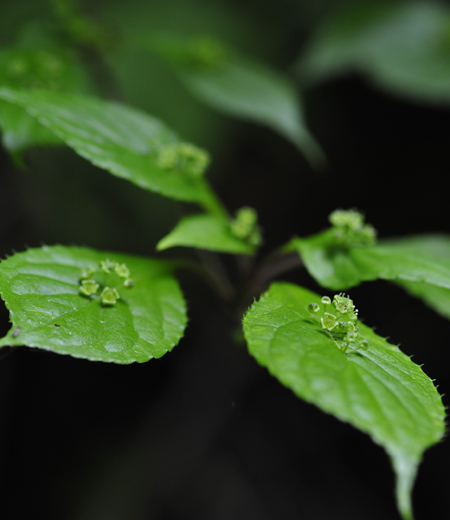 They are a deciduous shrub that grows wild at such humid places as in the pool of the forests along the mountain streams in the mountain area. The trunk grows together in cluster and is branched so often. Cortex of the young trees is smooth feeling to touch and shiny green color, while once grown ole trees turn into dark bistered. The characteristic is a small flower bloom in the middle of the leaf and people have used this appearance to resemble the one of a raft that looks like a leaf with a flower on it. This is how they are named. The leaves are wide elliptically-shaped about 6 to 12 cm long with thin and long sawtooth (Kyoshi: tooth-like rough part like a saw at the root of a leaf) at the edge. The blossom seasons are about May to June and hermaphroditism plant (Shiyuudousyu). On the main vein of the surface of the leaf, 1 female flower and several of male flowers gather to sprout. The flowers are pale green, about 5 mm long in diameter. The seeds are a spherical shape about 0.7 to 1 cm in diameter, and get matured to black-purple in August to October. The seeds taste sweet and young leaves are edible as Tempura and boiled leaves dish (Ohitashi).
They are a deciduous shrub that grows wild at such humid places as in the pool of the forests along the mountain streams in the mountain area. The trunk grows together in cluster and is branched so often. Cortex of the young trees is smooth feeling to touch and shiny green color, while once grown ole trees turn into dark bistered. The characteristic is a small flower bloom in the middle of the leaf and people have used this appearance to resemble the one of a raft that looks like a leaf with a flower on it. This is how they are named. The leaves are wide elliptically-shaped about 6 to 12 cm long with thin and long sawtooth (Kyoshi: tooth-like rough part like a saw at the root of a leaf) at the edge. The blossom seasons are about May to June and hermaphroditism plant (Shiyuudousyu). On the main vein of the surface of the leaf, 1 female flower and several of male flowers gather to sprout. The flowers are pale green, about 5 mm long in diameter. The seeds are a spherical shape about 0.7 to 1 cm in diameter, and get matured to black-purple in August to October. The seeds taste sweet and young leaves are edible as Tempura and boiled leaves dish (Ohitashi).
●Height about 1 to 3 m
●Place Trail 4, Trail 6, Ura-Takao -
Callicarpa japonica Verbenaceae
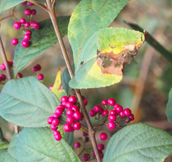
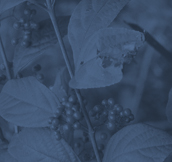 Callicarpa japonica Verbenaceae
Callicarpa japonica Verbenaceae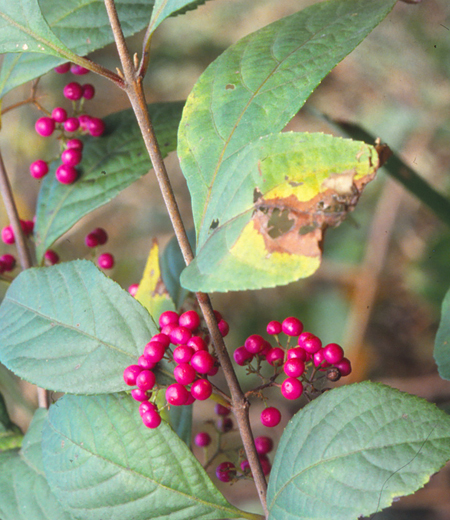 They are a deciduous shrub that grows wild in the pool at the plain field and in the forests at the mountain areas. Cortex is tinged with pale gray and smooth feeling to touch, but the one of old trees are vertically split and peeled off. As they bear burnished purple beautiful seeds, they are planted as garden trees so often, which is the reason for their name. In some cases, there are different group of Callicarpa dichotoma (Lour.) K.Koch (Komurasaki) among the gardening trees that are distributed. The leaves are elliptically-shaped, about 6 to 13 cm long, with the sharp top, and have sparse SENTEN tinged with yellow with a sawtooth (sawtooth: Kyoshi, serrated edges like a saw serrated edges at the tip of a leaf). The blossom seasons are about June to August and from the side of the leaf does inflorescence (Kajo: stalk blooming flowers) sprout out with many pale purple flowers. The flowers are about 4 mm long in diameter, with the upper portion split into 4 to be open flat as well as 4 male stamen outshoot long. The seeds are a spherical shape about 3 to 4 mm in diameters, and get matured in autumn.
They are a deciduous shrub that grows wild in the pool at the plain field and in the forests at the mountain areas. Cortex is tinged with pale gray and smooth feeling to touch, but the one of old trees are vertically split and peeled off. As they bear burnished purple beautiful seeds, they are planted as garden trees so often, which is the reason for their name. In some cases, there are different group of Callicarpa dichotoma (Lour.) K.Koch (Komurasaki) among the gardening trees that are distributed. The leaves are elliptically-shaped, about 6 to 13 cm long, with the sharp top, and have sparse SENTEN tinged with yellow with a sawtooth (sawtooth: Kyoshi, serrated edges like a saw serrated edges at the tip of a leaf). The blossom seasons are about June to August and from the side of the leaf does inflorescence (Kajo: stalk blooming flowers) sprout out with many pale purple flowers. The flowers are about 4 mm long in diameter, with the upper portion split into 4 to be open flat as well as 4 male stamen outshoot long. The seeds are a spherical shape about 3 to 4 mm in diameters, and get matured in autumn.
●Height about 2 to 3 m
●Place Mt.Inariy, Oku-Takao -
Lonicer gracilipes var. glabra Caprifoliaceae
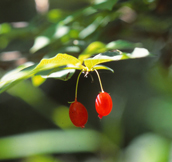
 Lonicer gracilipes var. glabra Caprifoliaceae
Lonicer gracilipes var. glabra Caprifoliaceae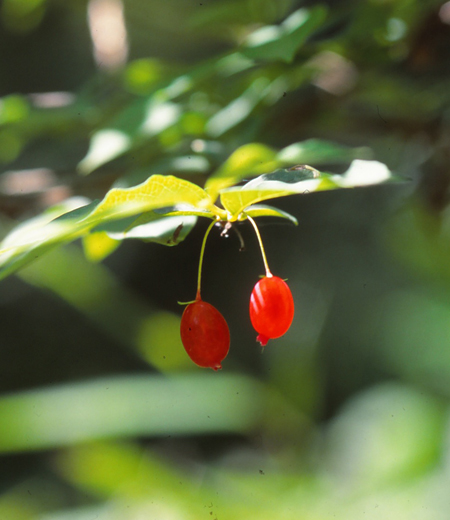 They are a deciduous shrub that grows wild in the pool and in the forests in the sunny forests at the mountain areas. Their branches often diverge to form dense beds. Cortex is tinged with blackish brown and the one of old trees is vertically split and peeled off, while young branch is tinged with a little bit red. The leaves are wide egged-shaped about 3 to 6 cm long, about 2 to 4 cm wide, and sprout sideways. The back of the leaves bear sparse trichome tinged with white color. The blossom seasons are about April to May. Inflorescence (Kajo: stalk blooming flowers) sprouts out, about 1 to 2 cm, on the branch that extend that year, and then dangle 1to 2 of pale showy pink flowers downwards. The flowers are thin, cylindrical shaped like a bugle, about 1 to 1.5 cm long with the top split into 5 to be open flat as well as male stamen outshoot long. The seeds are elliptically-shaped about 1 to 1.5 cm long, and get matured to red in June, sweet and edible.
They are a deciduous shrub that grows wild in the pool and in the forests in the sunny forests at the mountain areas. Their branches often diverge to form dense beds. Cortex is tinged with blackish brown and the one of old trees is vertically split and peeled off, while young branch is tinged with a little bit red. The leaves are wide egged-shaped about 3 to 6 cm long, about 2 to 4 cm wide, and sprout sideways. The back of the leaves bear sparse trichome tinged with white color. The blossom seasons are about April to May. Inflorescence (Kajo: stalk blooming flowers) sprouts out, about 1 to 2 cm, on the branch that extend that year, and then dangle 1to 2 of pale showy pink flowers downwards. The flowers are thin, cylindrical shaped like a bugle, about 1 to 1.5 cm long with the top split into 5 to be open flat as well as male stamen outshoot long. The seeds are elliptically-shaped about 1 to 1.5 cm long, and get matured to red in June, sweet and edible.
●Height about 2 to 3 m
●Place Trail 1, Mt.Inari -
Viburnum plicatum var. tomentosum Caprifoliaceae
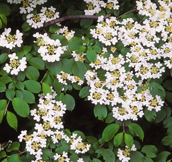
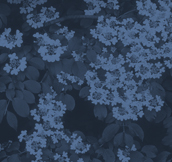 Viburnum plicatum var. tomentosum Caprifoliaceae
Viburnum plicatum var. tomentosum Caprifoliaceae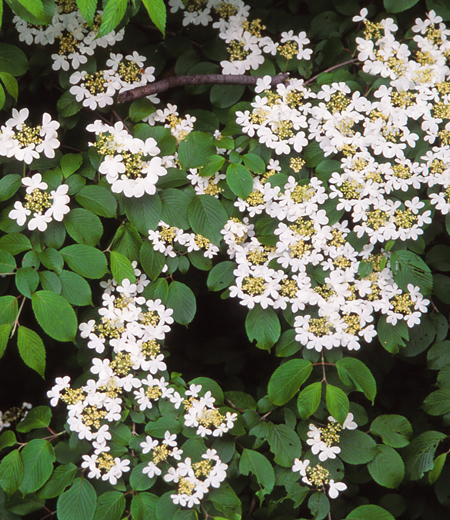 Deciduous small trees (less than 10 m tall tree that sheds its leaves once in a year) found in wet forest edges and waterside.Branches extend horizontally and young leaves are brown with hair. Barks are grayish-black, smooth and have irregularly placed lenticels (an opening that allows gases to be exchanged between air and the inner tissues of a plant). Leaves are 5 to 12 cm long and wide oval shape with pointed tip.Have hair on leaf veins on the back and toothed margins (edges of leaves are like a teeth of saw). Blooming season is from May to June, bloom 5 to 6 mm in diameter cream colored bisexual flowers (stamen and pistil coexist in one flower) surrounded by 3 to 4 cm in diameter white ornamental flowers (surround inflorescence have no stamen or pistils) on inflorescence (stem with flowers) grow from branches. This looks like thread ball, hence the Japanese name Yabu-demari literally means thread ball in shrubs. Fruits are 5 to 7 mm long and oval-shaped and after turning red from August to October, turn black as they ripen.
Deciduous small trees (less than 10 m tall tree that sheds its leaves once in a year) found in wet forest edges and waterside.Branches extend horizontally and young leaves are brown with hair. Barks are grayish-black, smooth and have irregularly placed lenticels (an opening that allows gases to be exchanged between air and the inner tissues of a plant). Leaves are 5 to 12 cm long and wide oval shape with pointed tip.Have hair on leaf veins on the back and toothed margins (edges of leaves are like a teeth of saw). Blooming season is from May to June, bloom 5 to 6 mm in diameter cream colored bisexual flowers (stamen and pistil coexist in one flower) surrounded by 3 to 4 cm in diameter white ornamental flowers (surround inflorescence have no stamen or pistils) on inflorescence (stem with flowers) grow from branches. This looks like thread ball, hence the Japanese name Yabu-demari literally means thread ball in shrubs. Fruits are 5 to 7 mm long and oval-shaped and after turning red from August to October, turn black as they ripen.
●Height about 2 to 6m
●Place Kita-Takao -
Viburnum dilatatum Caprifoliaceae
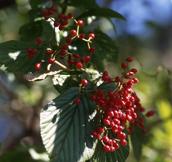
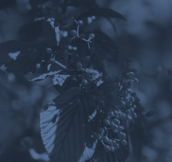 Viburnum dilatatum Caprifoliaceae
Viburnum dilatatum Caprifoliaceae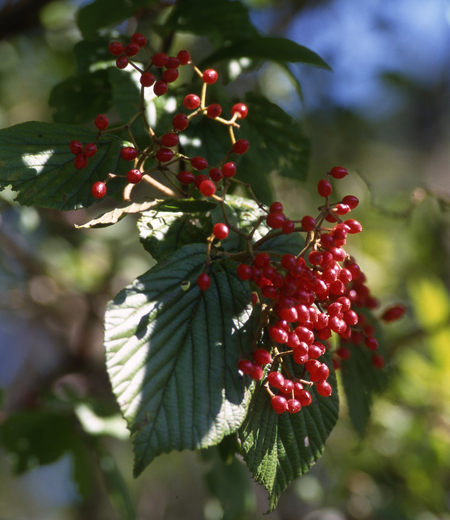 Deciduous shrubs found in sunny forest edge in mountains. Barks are gray-brown and smooth. Have lenticels (an opening that allows gases to be exchanged between air and the inner tissues of a plant) and fine splits are created as it grows. The stems become up to about 4 cm in diameter. Leaves are 6 to 14 cm long, 3 to 13 cm width, round-shaped with sharp tip with toothed margins (edges of leaves are like a teeth of saw). Have hair on both sides and distinct leaf glands (small glands to release secretion). Blooming season is from May to June. Bloom small white flowers in 6 to 10 cm in diameter inflorescence (stem with flowers). Flowers are 5 to 8 mm in diameter, lobed in five and petals flat with long stamens protruded. Fruits are oval-shaped, about 6 mm long and turn red from September to November. In winter, turns powdery white, become sweet and edible
Deciduous shrubs found in sunny forest edge in mountains. Barks are gray-brown and smooth. Have lenticels (an opening that allows gases to be exchanged between air and the inner tissues of a plant) and fine splits are created as it grows. The stems become up to about 4 cm in diameter. Leaves are 6 to 14 cm long, 3 to 13 cm width, round-shaped with sharp tip with toothed margins (edges of leaves are like a teeth of saw). Have hair on both sides and distinct leaf glands (small glands to release secretion). Blooming season is from May to June. Bloom small white flowers in 6 to 10 cm in diameter inflorescence (stem with flowers). Flowers are 5 to 8 mm in diameter, lobed in five and petals flat with long stamens protruded. Fruits are oval-shaped, about 6 mm long and turn red from September to November. In winter, turns powdery white, become sweet and edible
●Height about 2 to 4 m
●Place Trail 4, Mt. Inari, Oku-Takao -
Phasianus soemmerringii (Copper Pheasant) Phasianidae
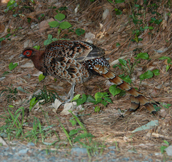
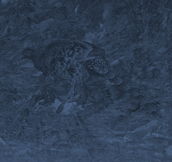 Phasianus soemmerringii (Copper Pheasant) Phasianidae
Phasianus soemmerringii (Copper Pheasant) Phasianidae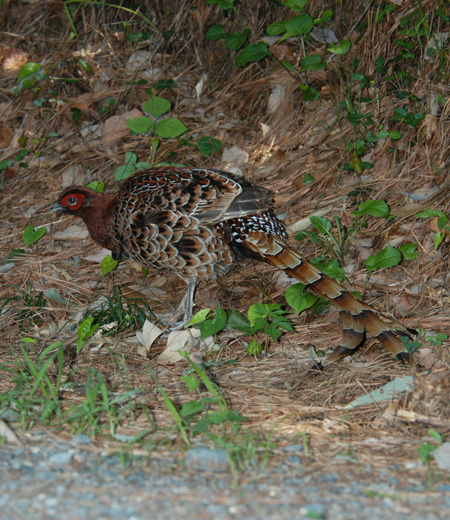 This is in the phasianidae family only distributed in Japan. This species is larger than the Japanese pheasant and the tail of males is longer than the head and body length. Whereas the Japanese pheasant prefers sunny areas, this species prefers shady forests. The body color is brownish for both males and females that blends in the background and is not easy to find them. The voice is not too loud “coo coo coo coo”. They walk between trees and hunt for insects, earthworms, seeds of plants and trees and buds of trees. The breeding season is from April to June, males become more active and do drumming (make sound by fluttering wings and make “doo doo doo doo” sounds) to announce their territory. They build a nest in hollows of a tree by collecting fallen leaves and tree barks and lay seven to ten eggs in a season.
This is in the phasianidae family only distributed in Japan. This species is larger than the Japanese pheasant and the tail of males is longer than the head and body length. Whereas the Japanese pheasant prefers sunny areas, this species prefers shady forests. The body color is brownish for both males and females that blends in the background and is not easy to find them. The voice is not too loud “coo coo coo coo”. They walk between trees and hunt for insects, earthworms, seeds of plants and trees and buds of trees. The breeding season is from April to June, males become more active and do drumming (make sound by fluttering wings and make “doo doo doo doo” sounds) to announce their territory. They build a nest in hollows of a tree by collecting fallen leaves and tree barks and lay seven to ten eggs in a season.
●Body Length (head to tail) Male about 125 cm / Female about 55 cm
●Season January to December (resident bird: a bird that stays in the same area all year round) -
Sphenurus sieboldii (Japanese Green Pigeon) Columbidae
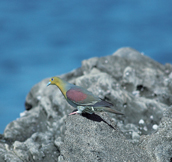
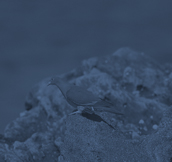 Sphenurus sieboldii (Japanese Green Pigeon) Columbidae
Sphenurus sieboldii (Japanese Green Pigeon) Columbidae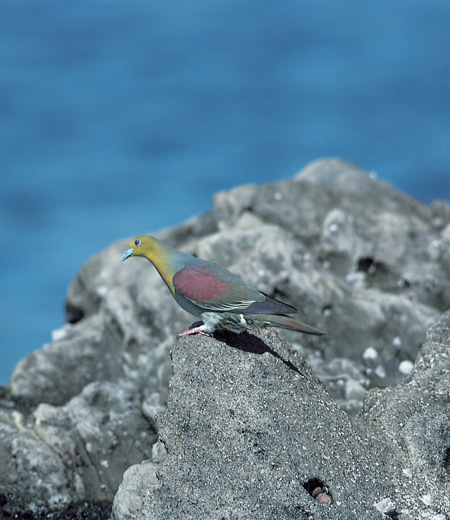 They are beautiful birds with a yellow-green body with a light blue bill. Male and female have almost the same body color but the male has purple feathers on wings. They live in a group in broad-leaved forests with Quercus acutissima, maple trees, Quercus crispula blume and hardly ever come out to open spaces. They feed on nuts like acorns, buds and fruits of trees. From early summer to autumn, they fly out to the coast to drink seawater and to hot springs for salty water. During the breeding season, males chirp like “oh ah oh” with lonely tones. In June, they build a dish-shaped nest with twigs and vines on a tree and lay two eggs in a season.
They are beautiful birds with a yellow-green body with a light blue bill. Male and female have almost the same body color but the male has purple feathers on wings. They live in a group in broad-leaved forests with Quercus acutissima, maple trees, Quercus crispula blume and hardly ever come out to open spaces. They feed on nuts like acorns, buds and fruits of trees. From early summer to autumn, they fly out to the coast to drink seawater and to hot springs for salty water. During the breeding season, males chirp like “oh ah oh” with lonely tones. In June, they build a dish-shaped nest with twigs and vines on a tree and lay two eggs in a season.
●Body Length about 33 cm
●Season January to December (resident bird: a bird that stays in the same area all year round, and wandering bird: a bird that has different areas for breeding and spending winter)(未翻訳)鳴き声を聞く
-
Cuculus poliocephalus (Lesser Cuckoo) Cuculidae
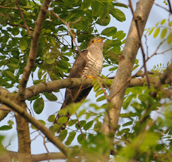
 Cuculus poliocephalus (Lesser Cuckoo) Cuculidae
Cuculus poliocephalus (Lesser Cuckoo) Cuculidae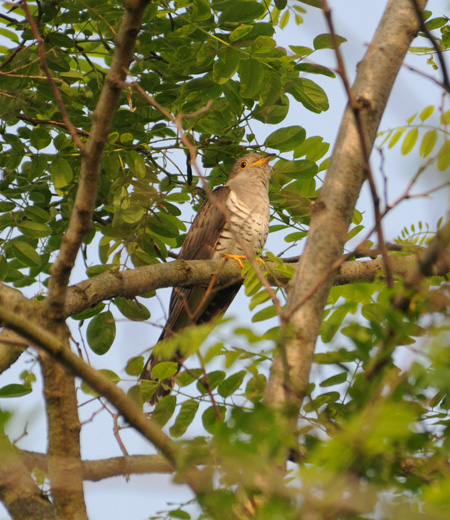 Is the same family with cuckoo and found in bright forests in low elevations. Male warbles loudly “kyo kyo kyo” sounding like “tokkyo kyoka-kyoku” literally meaning patent approval office, which is a very famous tongue twister. It also sounded like “hototogisu”, hence the Japanese name Hototogisui was named.
Is the same family with cuckoo and found in bright forests in low elevations. Male warbles loudly “kyo kyo kyo” sounding like “tokkyo kyoka-kyoku” literally meaning patent approval office, which is a very famous tongue twister. It also sounded like “hototogisu”, hence the Japanese name Hototogisui was named.
The back of adult birds is gray with black stripe patterns on chest. Male and female have same body color but some female are red-brown. Mainly feed on insects and hairy caterpillars and hornworms are favorites. Are brood parasites which means to lay eggs on other bird’s nest. Lay eggs often in bush warbler’s nest and the color of eggs are brown similar to the ones of bush warbler. The breeding season is from June to August. Take one egg out from the nest and lay one egg instead. In autumn, fly to Southeast Asia to spent winter.
●Body Length about 28 cm
●Season May to August (Summer bird, fly to one area from spring to summer for breeding and fly back to southern areas in autumn.)(未翻訳)鳴き声を聞く
-
Milvus migrans (Black Kite) Accipitridae
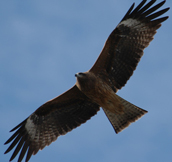
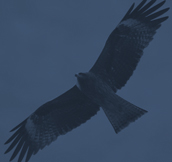 Milvus migrans (Black Kite) Accipitridae
Milvus migrans (Black Kite) Accipitridae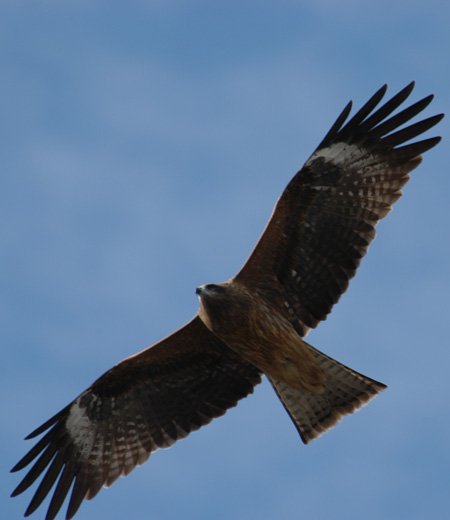 Is in a accipitridae family found at lakes, riverbeds and cities. Chirp “peep hyo lo lo lo” while hovering in a round route. Also known as tombi in Japanese. Is normally in a group except breeding season and hunt for preys from early in the morning. Feed on dead animals, fish, insects and frogs and sometimes raid garbage. The body color for male and female is almost the same and adults have dark-brown body. When looking up the sky while they are flying, their trapezoidal-shaped tails are clearly seen. The breeding season is from March to May and mostly in pairs and chirp frequently. Build a large sized dish-shaped nest with layers of twigs on a tall tree. Lay two to three eggs in a season.
Is in a accipitridae family found at lakes, riverbeds and cities. Chirp “peep hyo lo lo lo” while hovering in a round route. Also known as tombi in Japanese. Is normally in a group except breeding season and hunt for preys from early in the morning. Feed on dead animals, fish, insects and frogs and sometimes raid garbage. The body color for male and female is almost the same and adults have dark-brown body. When looking up the sky while they are flying, their trapezoidal-shaped tails are clearly seen. The breeding season is from March to May and mostly in pairs and chirp frequently. Build a large sized dish-shaped nest with layers of twigs on a tall tree. Lay two to three eggs in a season.
●Body Length Male about 58 cm / Female about 68 cm
●Season January to December (resident bird, bird that stay in the same area all year round) -
Accipiter gentilis (Goshawk) Accipitridae
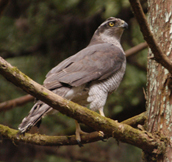
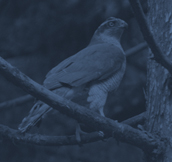 Accipiter gentilis (Goshawk) Accipitridae
Accipiter gentilis (Goshawk) Accipitridae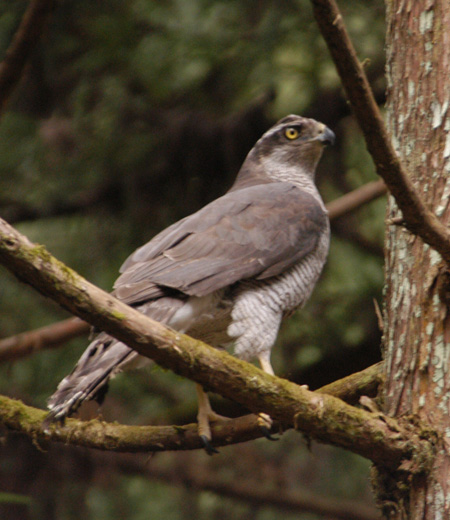 Found in forests from flatlands to mountains and also in cities. The body of adult birds is bluish gray and young birds are brown. Live alone except breeding season and hunt for pheasants, ducks, squirrels and wild rabbits. But feed on pigeons and crows in cities. The breeding season is from May to June. Build a large nest at the base of branches of large trees including pine trees and lay two to four eggs in a season. After egg hatches, male go hunting and give female preys by chirping “que que”. Re-use the same nest or use the same nest every two to three years.
Found in forests from flatlands to mountains and also in cities. The body of adult birds is bluish gray and young birds are brown. Live alone except breeding season and hunt for pheasants, ducks, squirrels and wild rabbits. But feed on pigeons and crows in cities. The breeding season is from May to June. Build a large nest at the base of branches of large trees including pine trees and lay two to four eggs in a season. After egg hatches, male go hunting and give female preys by chirping “que que”. Re-use the same nest or use the same nest every two to three years.
●Size male about 50 cm, female about 56 cm
●Season January to December(resident bird, bird that stay in the same area all year round, and wandering bird, bird that have different areas for breeding and spending winter) -
Strix uralensis (Ural Owl) Strigidae
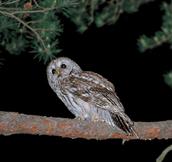
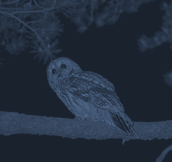 Strix uralensis (Ural Owl) Strigidae
Strix uralensis (Ural Owl) Strigidae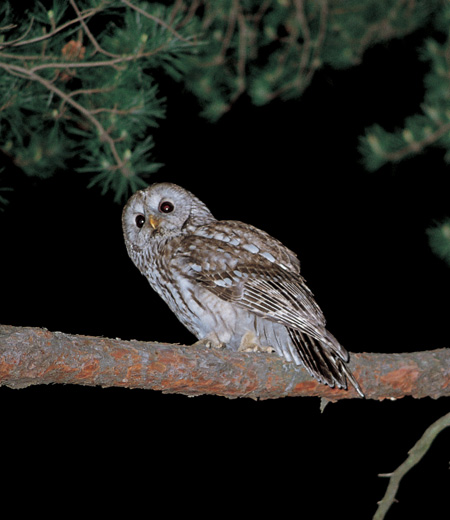 Live in forests and woods near resident area and live in shrines and temples in forests. Body color is the same for male and female. Body color varies by habitat. Are mostly gray and brown but become white in northern area. Live alone or in pairs and rest in shady forests and become active in late afternoon. Feed on rats, birds, lizards, frogs and insects. Hunt for these preys without flattering wings. Male and female chirp “ho ho” during breeding season. Build a nest in a hollow of large tree, ceilings of residence or shrines. Lay two to three eggs in a season from March to April.
Live in forests and woods near resident area and live in shrines and temples in forests. Body color is the same for male and female. Body color varies by habitat. Are mostly gray and brown but become white in northern area. Live alone or in pairs and rest in shady forests and become active in late afternoon. Feed on rats, birds, lizards, frogs and insects. Hunt for these preys without flattering wings. Male and female chirp “ho ho” during breeding season. Build a nest in a hollow of large tree, ceilings of residence or shrines. Lay two to three eggs in a season from March to April.
●Body Length about 50 cm
●Season January to December (resident bird, bird that stay in the same area all year round)(未翻訳)鳴き声を聞く
-
Ninox japonica (Brown Hawk Owl) Strigidae
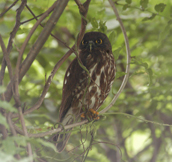
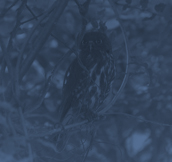 Ninox japonica (Brown Hawk Owl) Strigidae
Ninox japonica (Brown Hawk Owl) Strigidae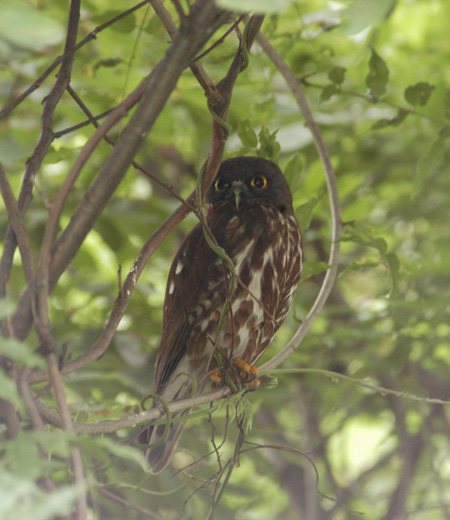 One of owls lives near residence area. Found on trees in cities, shrines and temples. The Japanese name Aobasuku literally meaning green leaves owls because they are seen from green season. The body color of male and female is almost the same, round-shaped head and dark brown face with gold eyes. Rest on trees during daytime and become active after chirping “hoot hoot” in pairs. Hunt for moths and gold beetles with foot and sometimes bats and small birds. The breeding season is from May to June, build a nest in tree hollows and spaces between buildings. Lay two to five eggs in a season. Female incubate eggs and male guard them. In autumn, fly to Southeast Asia to spend winter.
One of owls lives near residence area. Found on trees in cities, shrines and temples. The Japanese name Aobasuku literally meaning green leaves owls because they are seen from green season. The body color of male and female is almost the same, round-shaped head and dark brown face with gold eyes. Rest on trees during daytime and become active after chirping “hoot hoot” in pairs. Hunt for moths and gold beetles with foot and sometimes bats and small birds. The breeding season is from May to June, build a nest in tree hollows and spaces between buildings. Lay two to five eggs in a season. Female incubate eggs and male guard them. In autumn, fly to Southeast Asia to spend winter.
●Body Length about 29 cm
●Season May to October (Summer bird, fly to one area from spring to summer for breeding and fly back to southern areas in autumn.)(未翻訳)鳴き声を聞く
-
Yungipicus kizuki (Japanese Pygmy Woodpecker) Picidae
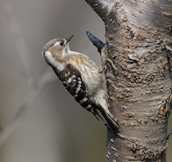
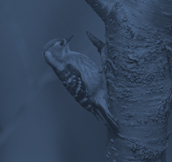 Yungipicus kizuki (Japanese Pygmy Woodpecker) Picidae
Yungipicus kizuki (Japanese Pygmy Woodpecker) Picidae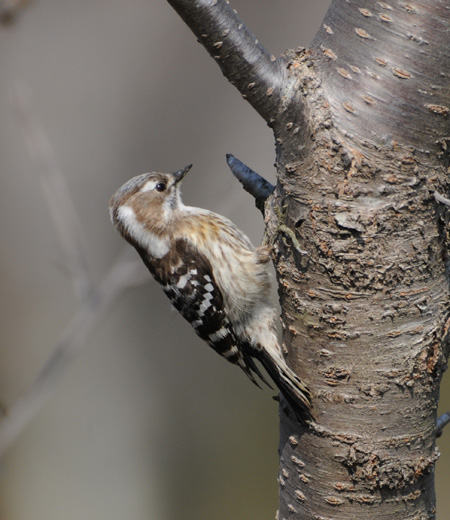 The smallest woodpecker found in Japan. The body color of male and female is almost the same but male have small red patterns on the back of head. Live in forests in mountains but sometimes breed at parks in cities. Live alone normally but come to residential area with a group of Japanese tit. Fly from trees to trees and hunt for insects and spiders and also feed on nectar of cherry blossoms by using tongues effectively. During breeding season, chirp “gee qui qui qi qi qi” and do drumming by tapping trees. Find half-dead trees and dig a hole and build a nest. Prefer trees of cherry blossoms and small mushrooms. From May to June, lay five eggs in a season.
The smallest woodpecker found in Japan. The body color of male and female is almost the same but male have small red patterns on the back of head. Live in forests in mountains but sometimes breed at parks in cities. Live alone normally but come to residential area with a group of Japanese tit. Fly from trees to trees and hunt for insects and spiders and also feed on nectar of cherry blossoms by using tongues effectively. During breeding season, chirp “gee qui qui qi qi qi” and do drumming by tapping trees. Find half-dead trees and dig a hole and build a nest. Prefer trees of cherry blossoms and small mushrooms. From May to June, lay five eggs in a season.
●Body Length about 15 cm
●Season January to December (resident bird, bird that stay in the same area all year round)(未翻訳)鳴き声を聞く
-
Picus awokera (Japanese Green Woodpecker) Picidae
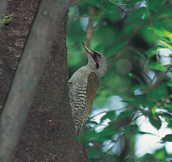
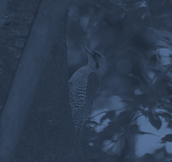 Picus awokera (Japanese Green Woodpecker) Picidae
Picus awokera (Japanese Green Woodpecker) Picidae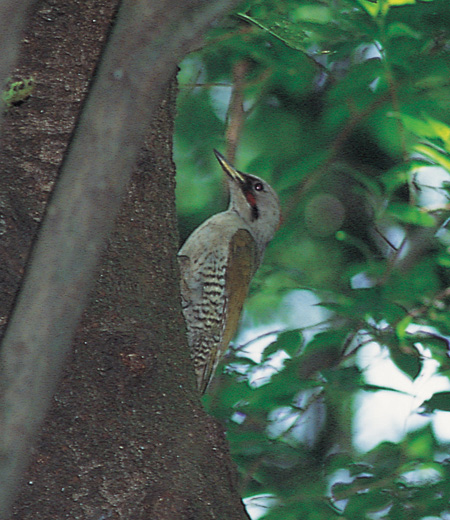 Is a woodpecker only live in Japan and found in forests from flatlands to mountains in south of Honshu area. Sometimes build a nest on cherry blossoms trees at parks in cities. The body color is grayish green with red on sides of a head and a bill. The body color for male and female is almost the same but male have larger red patterns and entire head is red. Fly from trees to trees by peck trunk of trees to catch insects and spiders and even ants on the ground. From autumn to winter, also feed on fruits and nuts of tree. The breeding season is from May to June. Chirp “pyo pyo” like whistles and do drumming. Nest in a tree by digging a with bill and lay seven to eight eggs in a season.
Is a woodpecker only live in Japan and found in forests from flatlands to mountains in south of Honshu area. Sometimes build a nest on cherry blossoms trees at parks in cities. The body color is grayish green with red on sides of a head and a bill. The body color for male and female is almost the same but male have larger red patterns and entire head is red. Fly from trees to trees by peck trunk of trees to catch insects and spiders and even ants on the ground. From autumn to winter, also feed on fruits and nuts of tree. The breeding season is from May to June. Chirp “pyo pyo” like whistles and do drumming. Nest in a tree by digging a with bill and lay seven to eight eggs in a season.
●Size about 29 cm
●Season January to December (resident bird, bird that stay in the same area all year round) -
Terpsiphone atrocaudata (Black Paradise Flycatcher) Monarchidae
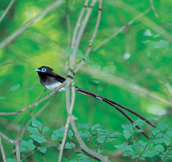
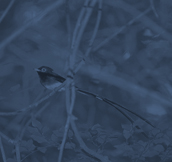 Terpsiphone atrocaudata (Black Paradise Flycatcher) Monarchidae
Terpsiphone atrocaudata (Black Paradise Flycatcher) Monarchidae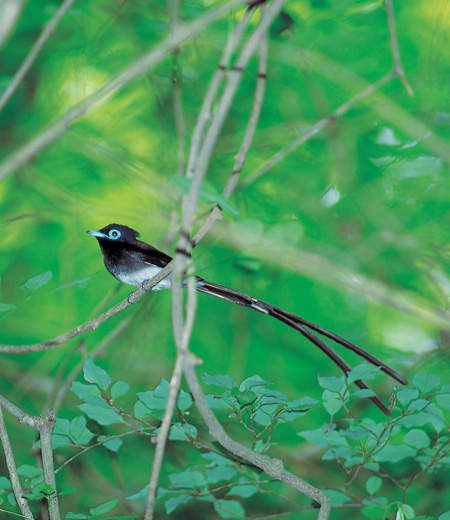 Fly back to Japan from Southeast Asia where they spent winter around April and breed in forests from flatlands to mountains. Chirp “two hee hoo shee hoi hoi” sounds like “Moon and star hoi hoi” for most of Japanese, hence the Japanese name is San-ko-chu literally meaning three lights birds. Around eyes and a bill is bright blue. Long tail is three times as large as body length for male and female have short tails. Are active in shady forets and hunt for insects and spiders in the air and at the tips of leaves. Build an upside down conical-shaped nest with moss, barks and threads of spiders. Lay three to five eggs in a season.
Fly back to Japan from Southeast Asia where they spent winter around April and breed in forests from flatlands to mountains. Chirp “two hee hoo shee hoi hoi” sounds like “Moon and star hoi hoi” for most of Japanese, hence the Japanese name is San-ko-chu literally meaning three lights birds. Around eyes and a bill is bright blue. Long tail is three times as large as body length for male and female have short tails. Are active in shady forets and hunt for insects and spiders in the air and at the tips of leaves. Build an upside down conical-shaped nest with moss, barks and threads of spiders. Lay three to five eggs in a season.
●Body Length Male about 45 cm, female about 18 cm
●Season April to August (Summer bird, fly to one area from spring to summer for breeding and fly back to southern areas in autumn.)(未翻訳)鳴き声を聞く
-
Garrulus glandarius (Eurasian Jay) Corvidae
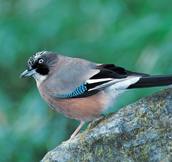
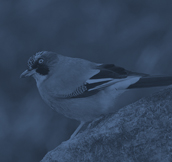 Garrulus glandarius (Eurasian Jay) Corvidae
Garrulus glandarius (Eurasian Jay) Corvidae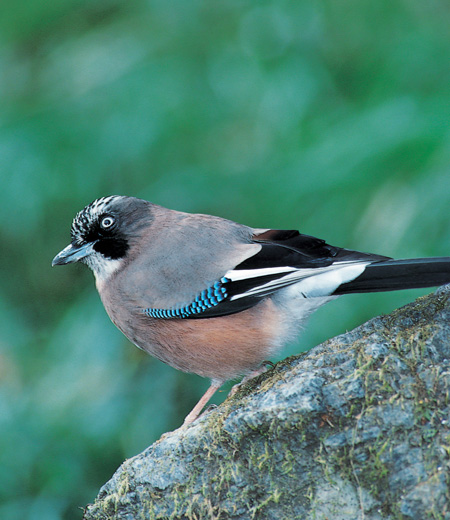 The body color of male and female is the same and brown on body with white and black patterns on head. Wings with black, blue and white patterns are distinct while flying. Found in shady forests from flatlands to mountains and live in a small group except breeding season. Walk like jumping on the ground or on trees and feed on insects, lizards and nuts of trees. The favorite food is acorns and sometimes hides them in hollows of trees or in soils. Chirp “Jyee Jyee“ with husky voice but good at pretending hawks and small birds. The breeding season is from April to June, build a nest at the base of branches and lay five to six eggs in a season.
The body color of male and female is the same and brown on body with white and black patterns on head. Wings with black, blue and white patterns are distinct while flying. Found in shady forests from flatlands to mountains and live in a small group except breeding season. Walk like jumping on the ground or on trees and feed on insects, lizards and nuts of trees. The favorite food is acorns and sometimes hides them in hollows of trees or in soils. Chirp “Jyee Jyee“ with husky voice but good at pretending hawks and small birds. The breeding season is from April to June, build a nest at the base of branches and lay five to six eggs in a season.
●Body Length about 33 cm
●Season January to December (resident bird, bird that stay in the same area all year round) -
Sittiparus varius (Varied Tit) Paridae
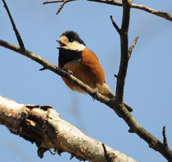
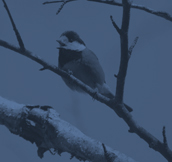 Sittiparus varius (Varied Tit) Paridae
Sittiparus varius (Varied Tit) Paridae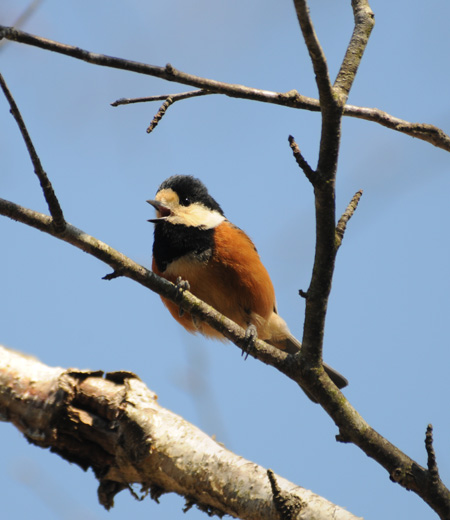 Found in forests from flatlands to low elevations and live around evergreen broad-leaved forests including camphor laurel and oak trees. They often come to residential areas. Live alone or in a small group except breeding season but some do stay in pairs throughout a year. The body color of male and female is almost the same with distinct bluish gray wings and nut-brown back and abdomen. Feed on bugs and nuts of trees. The favorite food is an acorn and holds them with legs and cracks them with bill to eat. Have a habit of hiding and storing acorns in hollows of trees or in soils for winter. The breeding season is from April to July and male chirps sounding like “tu tu pee tu pee”. Re-use the nest of woodpeckers or bird box and lay five to eight eggs in a season.
Found in forests from flatlands to low elevations and live around evergreen broad-leaved forests including camphor laurel and oak trees. They often come to residential areas. Live alone or in a small group except breeding season but some do stay in pairs throughout a year. The body color of male and female is almost the same with distinct bluish gray wings and nut-brown back and abdomen. Feed on bugs and nuts of trees. The favorite food is an acorn and holds them with legs and cracks them with bill to eat. Have a habit of hiding and storing acorns in hollows of trees or in soils for winter. The breeding season is from April to July and male chirps sounding like “tu tu pee tu pee”. Re-use the nest of woodpeckers or bird box and lay five to eight eggs in a season.
●Body Length about 14 cm
●Season January to December (resident bird, bird that stay in the same area all year round.)(未翻訳)鳴き声を聞く
-
Parus cinereus (Japanese Tit) Paridae
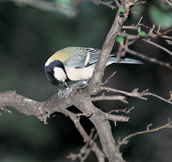
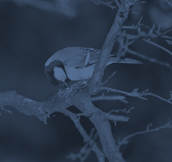 Parus cinereus (Japanese Tit) Paridae
Parus cinereus (Japanese Tit) Paridae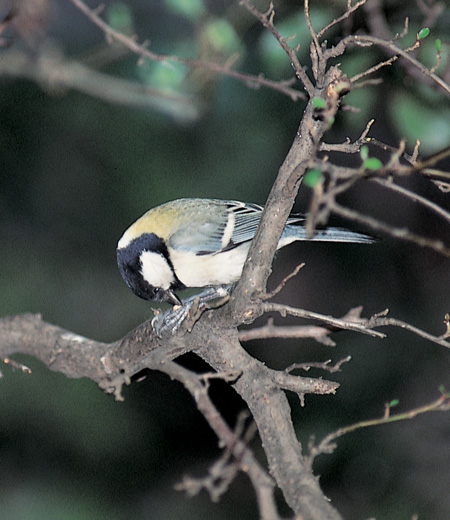 Have a distinct black tie-like pattern from throat to chest. The body color of male and female is almost the same but this pattern on male is wider than the one on female. Found in forests from flatlands to mountains and even at parks in residential areas. Are not afraid of human being and build a nest in letter boxes at houses or flower pots at gardens. Hunt for bugs and spiders on trees or on the ground and also feed on seeds of plants. Often come to feeding stations. Their favorite is sunflower seeds. Male chirps sounding like “tu tu pee tu tu pee” during breeding season. Nest in a hole or space between rocks but often use bird’s box. Lay seven to ten eggs from April to July.
Have a distinct black tie-like pattern from throat to chest. The body color of male and female is almost the same but this pattern on male is wider than the one on female. Found in forests from flatlands to mountains and even at parks in residential areas. Are not afraid of human being and build a nest in letter boxes at houses or flower pots at gardens. Hunt for bugs and spiders on trees or on the ground and also feed on seeds of plants. Often come to feeding stations. Their favorite is sunflower seeds. Male chirps sounding like “tu tu pee tu tu pee” during breeding season. Nest in a hole or space between rocks but often use bird’s box. Lay seven to ten eggs from April to July.
●Body Length about 15 cm
●Season January to December (resident bird, bird that stay in the same area all year round.)(未翻訳)鳴き声を聞く
-
Delichon urbica (Asian House Martin) Hirundinidae
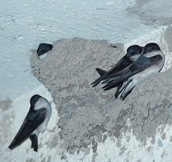
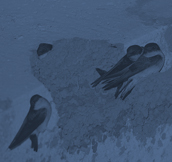 Delichon urbica (Asian House Martin) Hirundinidae
Delichon urbica (Asian House Martin) Hirundinidae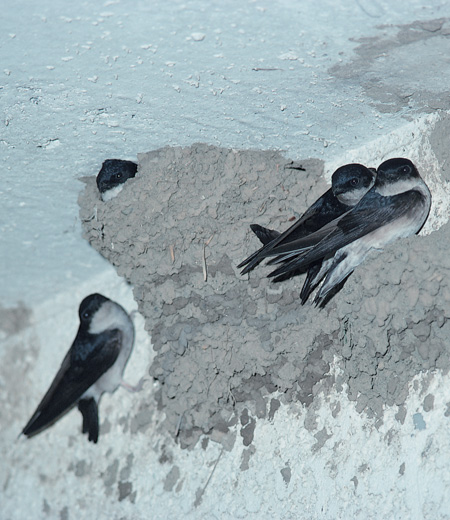 Fly back to Japan in the earliest time in spring from Southeast Asia. Body size is small and tail is short compare to house sparrow. Whereas house sparrow have red-brown rom face to throat, but this species have white throat. Live in a group in open fields from flatlands to high elevations. Catch mosquitos, moths and flies during the flight. Are used to nest in a group on rocky hills or caves along coasts but now below ceilings of building, stations, bridges and houses in cities as they are increased in number. Male chirp sounding like “pi li jyu li chi” during breeding season. Build a pot-shaped nest shaping muds and dry leaves with saliva and lay three to four eggs in a season.
Fly back to Japan in the earliest time in spring from Southeast Asia. Body size is small and tail is short compare to house sparrow. Whereas house sparrow have red-brown rom face to throat, but this species have white throat. Live in a group in open fields from flatlands to high elevations. Catch mosquitos, moths and flies during the flight. Are used to nest in a group on rocky hills or caves along coasts but now below ceilings of building, stations, bridges and houses in cities as they are increased in number. Male chirp sounding like “pi li jyu li chi” during breeding season. Build a pot-shaped nest shaping muds and dry leaves with saliva and lay three to four eggs in a season.
●Body Length about 15 cm
●Season March to about Octobers (Summer bird, fly to one area from spring to summer for breeding and fly back to southern areas in autumn.) -
Hypsipetes amaurotis (Brown-eared Bulbul) Pycnonotidae
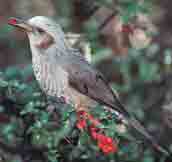
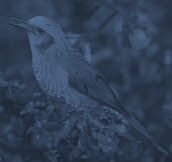 Hypsipetes amaurotis (Brown-eared Bulbul) Pycnonotidae
Hypsipetes amaurotis (Brown-eared Bulbul) Pycnonotidae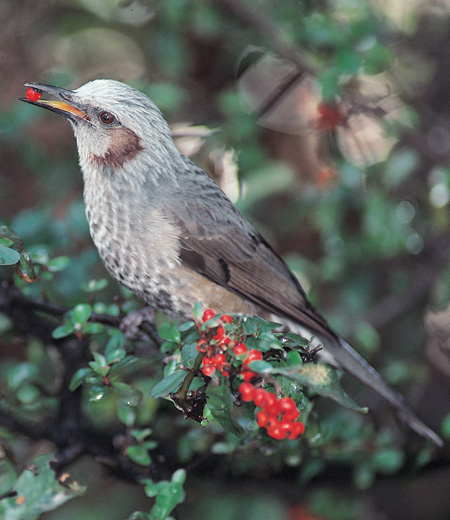 Found in forests from flatlands to mountains and also often seen in cities. Chirp loudly sounding like “hi hi heeyo heeyo”, hence the Japanese name Hiyo-dori. Mostly live on trees and hardly ever come down to the ground. Feed on fruits, nuts of trees, flowers, nectar, insects, chicks and lizards. Originally raise chicks from spring to summer in mountains and come to warm flatlands from autumn to winter but more and more species do live in cities or at parks throughout a year. The breeding season is from May to July. Build a nest with dead leaves and twigs and lay four to five eggs in a season. Sometimes plastic threads are used to build a nest. Are in a group of hundreds and fly short distance to the warmer areas (change habitats by season).
Found in forests from flatlands to mountains and also often seen in cities. Chirp loudly sounding like “hi hi heeyo heeyo”, hence the Japanese name Hiyo-dori. Mostly live on trees and hardly ever come down to the ground. Feed on fruits, nuts of trees, flowers, nectar, insects, chicks and lizards. Originally raise chicks from spring to summer in mountains and come to warm flatlands from autumn to winter but more and more species do live in cities or at parks throughout a year. The breeding season is from May to July. Build a nest with dead leaves and twigs and lay four to five eggs in a season. Sometimes plastic threads are used to build a nest. Are in a group of hundreds and fly short distance to the warmer areas (change habitats by season).
●Body Length about 28 cm
●Season January to December (resident bird, bird that stay in the same area all year round.) -
Horornis diphone (Bush Warbler) Cettiidae
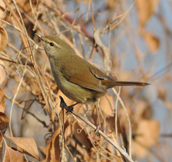
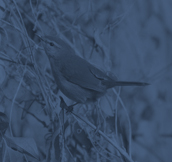 Horornis diphone (Bush Warbler) Cettiidae
Horornis diphone (Bush Warbler) Cettiidae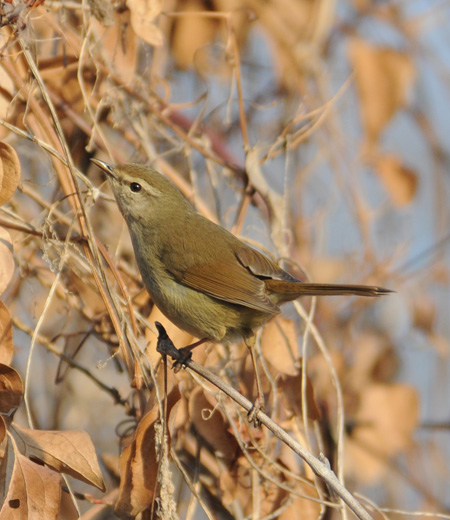 Are famous for their chirp sounding like ”Hō-hoke-kyo”. This is a male announcing own territory. Except this season and female normally chirp sounding like “cha cha cha”. Found in shrubs, forests and grasslands from flatlands to mountains and sometimes at parks in cities. The body color of male and female is almost the same, with grayish green body and light gray belt-like pattern above eyes. Live normally alone except breeding season and feed on bugs and spiders and fruits including persimmons. Rest placing a body horizontally to branches and change where they are looking by moving tails with rhythm. Fly in shrubs but does not fly long distance. The breeding season is from April to August. Build a ball-shaped nest with sasa leaves and dead Japanese pampas grass and lay four to six eggs in a season.
Are famous for their chirp sounding like ”Hō-hoke-kyo”. This is a male announcing own territory. Except this season and female normally chirp sounding like “cha cha cha”. Found in shrubs, forests and grasslands from flatlands to mountains and sometimes at parks in cities. The body color of male and female is almost the same, with grayish green body and light gray belt-like pattern above eyes. Live normally alone except breeding season and feed on bugs and spiders and fruits including persimmons. Rest placing a body horizontally to branches and change where they are looking by moving tails with rhythm. Fly in shrubs but does not fly long distance. The breeding season is from April to August. Build a ball-shaped nest with sasa leaves and dead Japanese pampas grass and lay four to six eggs in a season.
●Body Length about 15 cm
●Season January to December (resident bird, bird that stay in the same area all year round.) or nomadic bird)(未翻訳)鳴き声を聞く
